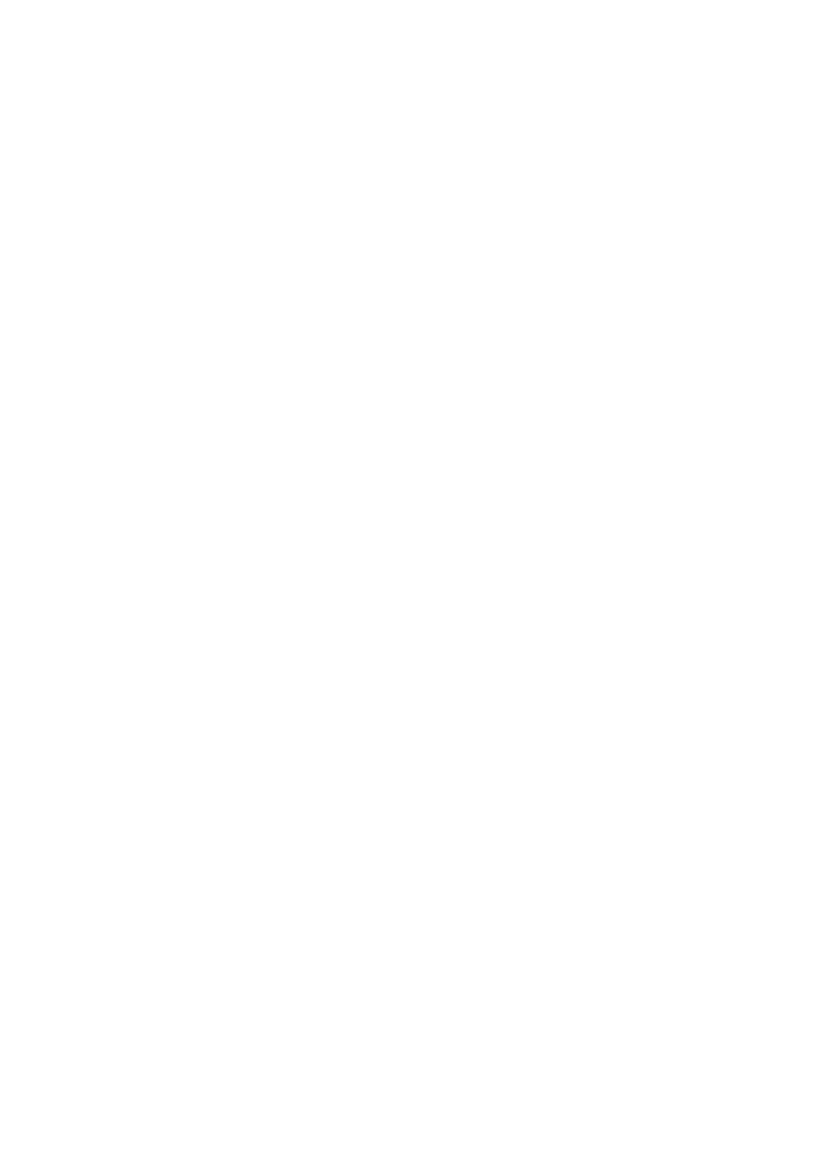Udvalget for Udlændinge- og Integrationspolitik 2012-13
UUI Alm.del Bilag 41
Offentligt
The Mandaean Associations Union19 Ketch Rd.Morristown, NJ 07960 ,USATel: +1 973 865 1340Fax: +1973 292 3906[email protected]www.mandaeanunion.orgθ
The Mandaean Associations Union
Mandaean Human Rights Group
Mandaean Human Rights Annual ReportSeptember 2011
Disclaimer:This report is the property of the Mandaean Associations Union (MAU). Any media use of all or part of this report shouldbe referred to the owner by name. Any other use must be approved by the MAU.
θθ
2
Version 7 – 13th August 2011 - MHRGThe Mandaean Human Rights Group(MHRG) is a self organised group dedicated to the helpand protection of fellow Mandaeans in Iraq and Iran, given the situation in those two countries.The Human Rights Group watches, investigates and exposes human rights violations againstMandaeans. We have volunteers in the United States, Canada, Australia, United Kingdom,Europe and Iraq. Our model in our work is the United Nation's Human Rights Declaration of1948. The MHRG is a non profit organisation registered at Companies House, UK 6271157. Itis a member of the Mandaean Associations Union.
AcknowledgmentWe gratefully acknowledge the dedicated help and advice of many organisations, without whichthis work would not have been completed. Numbered among them for this edition are:1. The Mandaean Associations Union2. The Spiritual Mandaean Council – Baghdad, Iraq3. The Mandaean General Assembly – Baghdad, Iraq4. The Mandaean Human Rights Association- Baghdad, Iraq5. The Mandaean Society in Jordan.6. The Mandaean Society in Syria.7. The Mandaean Society in Australia8. The Scientific Mandaean Society in Iran
θθ
3
ContentsDemography........................................................................................................................................................................................................ 4Short History of the Sabian Mandaeans ............................................................................................................................................................ 4Sabian Mandaeans after the fall of Saddam Hussein’s regime........................................................................................................................ 6Threat of Extinction..........................................................................................................................................................................................17The Mandaean refugees in the middle Countries, Syria and Jordan .............................................................................................................19What is the solution? ........................................................................................................................................................................................25For the Mandaeans inside Iraq:..................................................................................................................................................................25For the Mandaean refugees:.......................................................................................................................................................................26Conclusion.........................................................................................................................................................................................................29Appendix…………………………………………………………………………………………………………………………………30References ……………………………………………………………………………………………………………………………...56
AppendixAtrocities against the Sabian Mandaean religion followers since 2003........................................................................................................ 30List of the Murdered Mandaeans ............................................................................................................................................................... 30List of the Kidnapped Mandaeans.............................................................................................................................................................. 35Threats and Assaults ................................................................................................................................................................................... 40Rape ............................................................................................................................................................................................................. 47Conversion to Islam by Force .................................................................................................................................................................... 47Forceful Displacement from Al-Ramady Area to Syria ........................................................................................................................... 48Forceful Displacement from Al-Ramady Area to Jordan......................................................................................................................... 48Other Incidents ............................................................................................................................................................................................ 49Unconfirmed Atrocities .............................................................................................................................................................................. 51Photo evidence of some of the victims ...................................................................................................................................................... 52
θθ
4
The Sabian-Mandaeanreligion is one of the oldest monotheistic religions in the Middle East. It isindependent of Judaism, Christianity and Islam. It follows the teachings of John the Baptist; baptism beingits central ritual. Like most religions it emphasises marriage, family, and peaceful coexistence with othergroups. Mandaeans (Sabians or Sub’ba, in spoken Arabic) are the people who believe in this religion. Oneis born a Mandaean; the group accepts no converts. Well before the Islamic era and from early Christianity,Mandaeans have lived in Southern Iraq and Southern Iran. In Iraq, after WWI, they migrated to large citiessuch as Basra and Baghdad. Like Hebrews and Copts, Mandaeans are both a religious and ethnic minorthey are part of an endogenous Aramaic people. The word Mandaean refers to their distinct Aramaiclanguage, which is still spoken by Iranian Mandaeans. In Iraq on the other hand, the Mandaean languagesurvives only in liturgy.
DemographyAlthough it is difficult to estimate, the Mandaeans are around sixty thousand at the present time. More than5,000 Sabaean-Mandaeans remain in Iraq. Their decreased number is due to continued persecution andforced mass conversions, as well as relocation and assimilation. Currently, they live in large cities such asBaghdad, Umara and Basra with a few remaining in other Iraqi cities such as Nasiriya and southern Iraniancities like Ahwaz. During the past decade, and especially the past six years, thousands have fled Iraq andIran, choosing self-exile and immigration over death and persecution. More than 85% of the IraqiMandaean community has been displaced outside Iraq. The Mandaean community in Iraq has dwindledfrom more than 50,000 in the early 1990s to more than 5000 today but still the exact number is not known.Most have escaped to Syria and Jordan, and others have also fled to other countries. There are between4000 and 5000 Mandaeans in the United States, 800-1000 in Canada, 5,500 in Sweden, 3,500 in theNetherlands, 2200 in Germany, 600 in Denmark, 400 in Norway and Finland, in Austria, Hungary, Poland,Romania, Belgium, Bulgaria, Italy and France there are 500 Mandaeans, 400 in England, 4500-5000 inSyria, 300 in Jordan, more than 5000 in Iraq, 5000-8000 in Iran, 6000-6500 in Australia, 1 in Libya, 1 inYemen, and 20 in Dubai. Some are very desperate to reach western democracies and have fallen victim tohuman trafficking, spent all their savings and endured further difficulties in other countries.
Short History of the Sabian MandaeansIt is difficult to chart the origins and history of the Mandaean people because their literature does not dealwith these topics. Currently only one Mandaean text has emerged which refers, but in a very confusedmanner, to their history. It is the “Diwan of the great Revelation, called ‘Inner Haran’” or Haran Gawaita.In Haran Gawaita there is a description of the Nasoraeans (religious men in Mandaean language) escapingfrom persecution and staying in the “Median Hills” under the rule of King Ardban.King Ardban has been identified with the Parthian King Artaban III, IV or V. This description shows howthe Mandaean community, or part of it, penetrated into the Iranian territory of that time, that is during theperiod of the later Parthian kings, in the first or second century A. D. This same text describes how aMandaean community was established in Mesopotamia (Ancient Iraq), and discusses its further historyunder the Sassanian rulers.The emigration of the early Mandaean community from the Jordan valley in Palestine into easternterritories was brought about because of conflicts with the locals. It would probably have taken placeduring the second century A.D. at the latest, because several Mesopotamian and Parthian elementspresuppose a fairly lengthy stay in these regions. The emigrants went first to Haran, and the Median hills,and then entered the southern provinces of Mesopotamia. Haran Gawaita attests to the foundation of acommunity in Baghdad, i.e. in Mesopotamia, and the appointment of Mandaean governors in this region. Incontrast to the Parthian rulers, under whom the Mandaeans obviously prospered, relations with theSassanians were bad. The same scroll refers to a considerable reduction in the number of the MandaeanMandies (Worship Houses) at that time. It is also clear from the inscription of the Zoroastrian high priest,Kartar, that those practising non-Iranian religions, including Mandaeans, were persecuted during the reignof King ShahpurI.With the rise of Islam there came renewed oppression. In spite of mentioning the Sabians as “Peopleof theBook”in the Qur’an, Mandaeans were hardly ever tolerated. Thus, the afflicted community retired more
θθ
5
and more into the inaccessible marshes of southern Iraq and the river districts of Khuzestan, whereMandaeans are found until now. During this journey in history, Mandaeans were faced with severalmassacres and genocide attempts. Examples are as follows:1. The 14thcentury in Umara, Iraq by the hands of The Sultan Muhsin Ben Mahdi and hisson Faiadh the ruler of Shushter. Thousands of Mandaeans were killed1.2. The massacre of 1782 in South Iran and east Iraq when the Muslim rulers wanted theMandaean books and the Mandaeans refused to give it in fear of destruction. Leaders ofthe community were tortured and killed and the rest had to escape23. The massacres of Muhamra 18373.4. The massacre of Suk Al-Shiuk 18394.5. The Massacre of 1870 in Shushter By the hands of Nassir Al-Deen Shah, the ruler of Iran5.2
In the beginning of the twentieth century, the Mandaeans returned to the large cities (Baghdad and Basra),and found opportunities for education and social improvement. After the First World War and with the riseof Turkish nationalism, Arab nationalism took precedent over religion and the Arab Muslims fought againstthe Muslim Ottoman Empire. A new phase of persecution appeared where the ethnic identity of minoritiesin the Arabic Islamic rule had to dissolve in the pan Arab chauvinistic identity. This included theMandaeans, Christians, Kurds and all other ethnicities. The Mandaeans lost their language (MandaeanAramaic), distinctive dress and heritage to Arabic culture. This “Arabisation” process, especially in 1950 tothe 1960s, adversely affected their religion6. Mandaeans were forced to deny certain Mandaean mandates.For instance, as Mandaean children attended schools they were required to cut their hair and beards, whichis in direct violation to Mandaean rules. Since the sons of priests are barred from the priesthood if they cuttheir hair or beards, this forced act has restricted the pool of acceptable applicants. In addition, they weredrafted by force in the armed forces again against their religious mandate which prohibit carrying guns7.67
During the Baath and Saddam era the Mandaeans were under extreme pressure. The dictatorship affectedthe Iraqi society over the last several decades in a brutal way. This dictatorship held an iron grip over allIraqis and stained the recent history with terror and blood of the innocent people. The Mandaeans took theirshare of misery, pain and all kinds of suffering. Several hundred Mandaeans were murdered by theauthorities during Saddam rule, for trying to express their thoughts in public. Hundreds of their young menand women were killed, condemned to horrible tortures, or simply vanished. Hundreds more were killedduring the Iraq-Iran war, under the forced drafting rules, a substantial portion of the young male population.They were forced to go against their religious doctrine of not carrying weapons and never shedding blood,even in self-defence8.T
The concept of freedom in the Baath regime, especially religious freedom, was directly correlated with thepersonal favour demanded of Saddam Hussein and the regime9.The Mandaeans were not an exception; theysuffered politically, economically, socially, and religiously from persecution. Moreover, the Mandaeanshave endured severe discrimination in employment, education, the legal system, and been subjected toforced military service and social shunning. This forced over 15,000 of the Mandaeans to flee from Iraqduring that period which represents a major percentage of the total numbers of the Mandaeans in Iraq,12making them the most affected minority. Also, the interference of authorities in religious matters anddecisions, led lots of the Mandaean priests to leave Iraq.Mandaeans of Iraq and Iran by Lady Drowere, E. S., P 56 - 572 Jean de Morgan (mission scientifique en Perse ) volume 53 Glimpses of Life: Yahia Bihram Mandaean Priest by Jorunn J. Buckley- (History of Religions 1999 pgs 32 – 49)4 ibid5 Stories from a life of Ameer by Mahmooh Hamidi (Persian) P 1616 Drower, E. S., The Thousand and Twelve Questions (Alf Trisar Suialia), edited in transliteration and translation by E. S.Drower(Akademie Verlag Berlin: 1960 (page 1 – 2)7 Drower, E. S., The Thousand and Twelve Questions (Alf Trisar Suialia), edited in transliteration and translation by E. S.Drower (Akademie Verlag Berlin: 1960 (page 2)8 List of names can be obtained from the Mandaean Human Rights Group directly ([email protected])9 International Religious freedom report 2003 Released by the Bureau of Democracy, Human Rights and labor10 A comprehensive report about that period has been issued by the Mandaean Human Rights Group and can be requesteddirectly from the MHRG . also look at : http://mandaeanunion.org/HMRG/EN_HMRG_002.htm10.1 http://frwebgate.access.gpo.gov/cgi-bin/getdoc.cgi?dbname=111_cong_bills&docid=f:sr322ats.txt.pdf10.2 http://www.refugeecouncil.org.au/docs/resources/2011-12_IntakeSub.pdf11 http://mandaeanunion.org/HMRG/Mandaean_Human_Rights_Annual_report_March%20_2008.pdf1
θθ
6
During the last decade and before the fall of the Saddam regime, there was a surge in Islamicfundamentalist ideology both in the Sunni and Shia’a schools of thought resulting from many factors out ofthe scope of this report. These extreme Islamic views carry, among other things, an extreme view of howMuslims should deal with other religions such as Christianity, Judaism and Mandaeanism. Rejection andforced conversion to Islam are the only solutions these ideologies would expect. The extreme Muslimshave been using all possible means including money, threats, kidnapping, intimidation and even murder, inorder to force other religious minority members such as Mandaeans to convert to Islam. These tactics weresuccessful with a lot of Mandaean families in areas like Faluja, Ramadi and some areas in Baghdad. Theuse of threats, intimidation, brainwashing of children, and kidnapping of girls forced a lot of Mandaeanfamilies to surrender completely and accept their fate. During that period many Mandaeans were killed fortheir faith only10.Mr. Abdulhasan Majeed Jaber (born 1950) 18 yrs. old daughter Nisreen and 15 yrs. old Son Rafil werekidnapped in 1991 from Al-Shaeb quarter in Baghdad and converted to Islam, family were threatened andcalled infidals and Mr. Jaber was imprisoned and tortured for 42 days. He received another threat to kidnaphis wife Adeebah and young son Alaa if he tries to look for his children.According to the Senate of the United States in its resolution S. RES. 322 on 5thof August 2010, ‘Whereasduring the 35-year rule of the Baath Party and Saddam Hussein, and despite the Provisional Constitution of1968 that provided for individual religious freedom in Iraq, the Government of Iraq severely limitedfreedom of religion, especially for religious minorities, and sought to exploit religious differences forpolitical purposes.’ ‘Because of systematic, ongoing, egregious violations of religious freedom’ ref 10.1.The Australia Refugee and Humanitarian Program 2011-12 stated that ‘During the regime of SaddamHussein (1979-2003) an unknown number of people were captured, tortured, forced from their homes orkilled. Kurds, Shias, Turkomans, Christians and Assyrians became victims of the Government’s“Arabisation” policy and dissidents considered to be opponents to the regime were also targeted’ Ref 10.2.Sabian Mandaeans after the fall of Saddam Hussein’s regimeMandaeans, like all Iraqi people, were looking forward to a new era after the fall of the Saddam regime.They were looking for a better treatment by authorities based on citizenship and equality, but unfortunatelythis did not materialise. Warlords and militia controlled the streets for a long time. Religion based gangsand criminals held the laws in their hands, and common criminals were unleashed. The government failedto secure safety and security due to several reasons such as the intrinsic make up of the sectarian basedsharing of power, which left the minorities, and especially the Mandaeans, with no protection. TheMandaeans are pacifists who have no clan system of protection and have no enclave to run to in times ofdanger. Their only self-defence means are argument, pay money or escape. All the atrocities that theMandaeans have passed through since 2003 are documented in our previous reports11’12’13’14’15.Australia’s Refugee and Humanitarian Program 2010 – 2011 report from the Refugee Council of Australiastates the fact that political turmoil in Iraq has been ongoing for a number of decades. The Iran-Iraq Warfrom 1980 to 1988, the 1990 Iraqi invasion of Kuwait, the first Gulf War from 1990 to 1991 and theCoalition invasion of 2003 have all contributed to an environment of insecurity and economic hardship forthe local population.10.3
The Hudson Institute in its report titled “Iraq’sVulnerable Religious Minorities.”Onthe 13thof July 2010stated:‘Relentless waves of bombings, assassinations, kidnappings, extortions and rapes have triggered amass exodus of Christians, Mandeans, and Yizidis from Iraq over the past seven years. Thiscontinued this year,’ (2010)15.
12 http://mandaeanunion.org/HMRG/Sabian_Mandaeans_in%20Iraq_Face_Annihilation_2007_MHRG_report.pdf13 http://mandaeanunion.org/HMRG/EN_HMRG_011.html14 http://mandaeanunion.org/HMRG/HR_report_2005.pdf15 http://mandaeanunion.org/HMRG/EN_HMRG_001.htm15.1http://www.hudson.org/files/publications/STATEMENT%20OF%20NINA%20SHEA.pdf
θθ
7
These are examples of recent crimes against Mandaeans since our last reportOn 5thof June 2011 two young men were kidnapped, Mr. Salem Latef Ghanem 36 years old and Mr AsadSabih Ghanem 42 years old. On their way to Basra they were stopped by a policed uniform unit. They weredetained and kept in a isolated hut in the mashes near Al-Izier. They were tortured severely until theydisclosed all their valuables worth an estimated $99,000.On 23rdof February 2011 Mr. Salim Ayesh was found dead tied to a chair in his own house in Baghdadwith multiple shots to his body, while his family were away.On Thursday 13thJanuary 2011, while walking home after work Mr. Iyad Neseri Alshawi; a young manwith four children was shot in the head and was killed.The MHRG released another circular to all its contacts on 17thJanuary 2011 about the incidents. Anothersimilar circular was distributed on 24thMay 2010 titled “For how long will the international communitywatch before it acts to stop the ethnic cleansing of the Mandaeans in Iraq.”On 22ndMay 2010 a young Mandaean man Mr. Baha Sori Zaggi was killed on his way home from work.He had been kidnapped before and paid a ransom of $25,000. He was an IDP and was returned from arefugee country back to his area of Al-Dorrah in Baghdad. He had received threats prior.Another crime against the Mandaeans of Iraq was committed on 25thApril 2010 in Al-Soyyrah city – Kut,south of Baghdad, a young man aged 27, Mr Bassam Hassaney Raheim, was shot in the head by unmaskedmen with silenced guns in a busy marketplace in the early hours of the morning. He was transferred to ahospital in Baghdad and he died later on in hospital from his injuries on 28thApril 2010.This follows another similar killing with silenced guns with shots to the head, also to another Mandaeanman Mr. Niem Younes Medlol on 8thFebruary 2010 in Al-Saiedia district in Baghdad, which also tookplace in the early hours of the morning in a busy marketplace. Mr Niem Younes Medlol had returned toBaghdad from Syria to support his family as they had exhausted all their funds.In March 2009, the Amnesty International released a report about women in Iraq, in which (on page 2) itstates that “One morning, four armed masked men forced their way into a family home in Baghdad. Thechildren and their father were beaten and shackled. Their pregnant mother was forced into another room,kicked in the abdomen, burnt with a cigarette and raped. The rapist said that he wanted to make hermiscarry because of her religion. The mother lost consciousness during the assault and woke up in hospitalto discover that her pregnancy had been terminated due to the injuries caused by the attack. The family,who are members of the religious minority Sabean-Mandaean community, subsequently fled the country16”.This was one of many cases where the identity of the victims was hidden. Many other cases werenot reported due to fear and on specific request of the families. In an article on Middle-East Online it wasclaimed that since 2003 about 800 members have been killed.17The Society for threatened people GfBV, referred to another incident which took place on March 26 2008in the city of Kute in Iraq where a missile attack took place on a house inhabited by two Mandaean familiescausing the destruction of the house and the deaths of nine women and children, as well as one young man.Another young man was seriously injured. Immediately after the attack the house was looted of its contentsby armed men. Moreover the death certificates of the deceased were inconsistent and showed differentcauses of death. However, the house next door was not damaged by effect of the missile18. This case wasreported against unknown persons and the investigation was closed by the Interior Ministry of Iraq.The details of this case was reported according to the model questionnaire provided by theSpecial Rapporteur on freedom of religion or belief at the Office of the High Commissioner forHuman Rights (OHCHR), United Nations at Geneva, according to resolution 6/37 of December14th 2007, The Human Rights Council.
θθ
8
It is worth mentioning that most of the cases of killing were followed by threats to the bereaved familiesnot to report to the police. These threats were delivered by the tribes or clans of the criminals in which theyalso threaten them to leave their homes or else be killed. The USCIRF (United States Commission onInternational Religious Freedom ) met with family members of the deceased in Syria in May 2008, and wastold, before the attack…had received numerous threats and warnings from extremists because of theirreligion (page 42 of Annual Report May 2009)19.The UNHCR April 2009 Report on the UNHCR Eligibility Guidelines for assessing theInternational Protection Needs of Iraqi Asylum-Seekers, mentions that on September 8 2008, agroup of men armed with silenced guns shot three Mandaeans in their family jewellery storelocated in a busy market in Al-Sha'ab district of Baghdad. Two brothers and an eight-year oldboy were killed in this crime with multiple shots to their heads and chests. In addition, thevictims’ store was looted20.In a press release on August 11 2009, it is mentioned that based on the MHRG, on Thursday6thAugust 2009, another Mandaean goldsmith (Mr. Weam Abdul-Nabi Lazim) was massacred bygunmen in his jewellery shop in Iskan district in Baghdad, Iraq. The witnessed killing whichhappened in midmorning, was professionally executed using pistols with silencers, and took placein a closed pedestrian busy shopping centre with security controlled entrances and exits. The same methodwas used a few months ago when they killed three goldsmiths in Tobchi area, Baghdad and a few weeksbefore that, the killing of three goldsmiths with their eight-year-old son in Shaab area, Baghdad21.On 2ndSeptember 2009, Abdul Wahid Al-Bender and his family, (while at their house in Baghdad-Aljedida city), were attacked by armed men resulting in the killing of this elderly gentleman which also lefthis wife injured. When his sons tried to defend themselves, they were arrested by the authorities. Not eventhat, the clans of the killers are now threatening to kill all the family. This “clan” action also stopped otherMandaeans from reporting a lot of atrocities in fear of revenge22. Another heinous crime against theMandaeans of Iraq was committed on Saturday 19thSeptember 2009. This time it was in Basra, Iraq. Twoyoung goldsmiths, Mr. Farqad Faiq Authman and Mr. Muhand Qasim Abdul-Razzaq, both in theirtwenties, were massacred by four unmasked gun men using silenced guns and knives. After several bulletsin their heads they were knifed down and left to die in their shops. The gunmen looted the shops andescaped. This happened in the early morning hours in a crowded market, and no one stood up to help23.In the case of Mrs. Ensam Mubark Mehalhal when her 10-year-old son, Saeed M. Shadood, was kidnappedfor the first time on 19thMarch 2009, she immediately went to the police. She was told to wait three daysbefore coming back as it was still too early. The kidnappers called her a few hours later and told her that ifshe contacted the police again they would kill her son (they immediately knew that the police had beencontacted). Relatives had to borrow and pay the ransom of 30,000 US dollars to release the child after hehad been beaten, tortured and sexually assaulted. A month later on 5thJune 2009, both the mother and herson were kidnapped again for two weeks. Both were beaten, tortured, their bodies were cut with razors, andthey were sexually assaulted, with continuous insults for being kaffir (infidel) and dirty. Relatives paid aransom of $US 40,000 to release them. The incident was reported to the Iraqi police, US FBI, StateDepartment and the US Embassy in Baghdad as her brother-in-law is an American Mandaean citizen andwas involved in the demands to pay the ransom which he refused to pay.In our May 2010 release, we pointed out that recent incidents are taking a cyclical pattern which raises thepossibility of a programmed cleansing as it is not related to the security situation in Iraq, in general. Takinginto consideration the small number of Mandaeans that stayed in Iraq and despite being very careful andvigilant the incidents caused a lot of fear and disturbances in our communities, inside of Iraq, our refugeesin Syria and other countries.3
23.1 http://uscirf.gov/news-room/press-releases/3480--uscirf-urges-upgrading-security-in-iraq-for-christians-and-other-imperiled-religious-communities.html23.2 http://www.humanrightsfirst.org/wp-content/uploads/Living-in-Limbo-Fact-Sheet.pdf23.3 http://www.amnesty.org/en/library/asset/MDE14/002/2010/en/c9dc5d8d-95fa-46e4-8671-cd9b99d0378c/mde140022010en.pdf24 http://www.chathamhouse.org.uk/news/view/-/id/373/25a http://www.amnesty.org/en/library/asset/MDE14/002/2010/en/c9dc5d8d-95fa-46e4-8671-cd9b99d0378c/mde140022010en.pdf
θθ
9
It has been noticed that the killing incidences are taking a semi-periodical sequence and there is aproportional increase in the number of kidnappings which entail various torture methods used onthe victims. Many kidnappings especially those ended by the release of the kidnapped for ransomwent unreported for various reasons, not least because the kidnappers threaten them to keep quiet.In our attached atrocities report from September 2009 till date the MHRG investigated 31murders of Mandaeans, 14 kidnappings with severe assaults, torture and humiliation with ransompaid, and 33 attacks, attempted murders by weapons which left many bullet wounds that resultedin hospitalisation, mortar attacks, house bombings, threatening letters, arson attacks againstelderly people, threat of forced conversion, and paying religious tax (Jizya in Islamic wording). Italso included reports of atrocities that have not been reported by families during previousperiods. The appendix also shows the numbers of Mandaeans killed, kidnapped, or attackedsince 2003.Several religious clergy have also been assassinated (please refer to the MHRG 2009 Annual Report)These circumstances forced a continuous wave of Mandaeans escaping from Iraq; hence our statistics showthat in 2009,300 families escaped to Syria and 50 families escaped to Jordan. In 2010, 130 families escapedto Syria and 20 families escaped to Jordan, but these figures are out of the limited numbers of remainingfamilies. The cause for this is quite clear from the following sources.•
••
USCIRF. (United States Commission on International Religious Freedom.) In a press release titledUSCIRF Urges Upgrading Security in Iraq for Christians and Other Imperiled ReligiousCommunities on 14thDecember 2010 stated that ‘The smallest Iraqi religious groups — includingChaldoAssyrian, Syriac, and other Christians; Sabean Mandaeans; and Yazidis — face targetedviolence, including murders and attacks on their places of worship and religious leaders,intimidation, and forced displacement; they also experience discrimination, marginalisation, andneglect.’Human Rights First stated that the horrific attacks on the Christian communities in October andNovember confirm that religious minorities continue to face grave risks in Iraq.Amnesty international states that the fear for their lives has driven a disproportionately highnumber of members of minority communities to flee Iraq in recent years. The UN SecretaryGeneral reporting on the situation in Iraq in July 2009 noted that “the recent surge in violence,particularly against minorities, has led to a continuation of Iraqis leaving the country as well assome internal displacement.23.123.223.3
Many insurgencies involving a number of communities and organisations are struggling forpower inside Iraq at the moment. The conflicts have become internalised between Iraqis as thepolarisation of sectarian and ethnic identities reached ever deeper into Iraqi society and hascaused the breakdown of social cohesion. This fact was recognised in a Chatham House Reportin May 2007, titled “AcceptingRealities in Iraq”which still holds true).244
Despite this report being released in 2007, it was noted by Amnesty International in their report ‘Iraq:Civilians Under Fire’ dated April 2010, that ‘exposed again the vulnerability of minority groups. More thana hundred people were killed between mid-July and mid-September 2009 in attacks targeting Christians,Sabean-Mandaeans, Yazidis, Turkoman Shi’as, Shabaks and Kaka’is.’ Ref 25aIWPR (Institute for War & Peace Reporting.) recently stated in its 26thFebruary 2010 report that “All therecent events - bombs, beheadings, and assassinations - are obvious indicators of the return of sectarianviolence. These are signs that sectarianism still exists in the country”.It also stated that “There is still fire under the ash; there are hidden sectarian hatreds and we expect moresectarian violence ahead of the election and even after it.”25.125.2
There were claims about an improvement in security in Iraq. However, this is yet to be seen andfelt by our community in Iraq. The reality on the ground gives a completely different picture.Our sources identified increased atrocities per capita of Mandaeans across Iraq, which makes the25.1 http://iwpr.net/report-news/iraqis-fear-renewed-sectarian-violence25.2 http://iwpr.net/report-news/iraqis-fear-renewed-sectarian-violence
θθ
10
return of those who fled the country much more difficult.In our 2009 report, we mentioned that in July 2009, a report from Measuring Stability and Security in Iraqto the congress, states (on page vii) that, “To institutionalise its sovereignty and stability, the GOI(Government of Iraq) must build its legitimacy through the provision of basic services and improvedsecurity for the Iraqi people, as well as the continued resolution of political, ethnic, and sectariandivisions”.Also, (on page viii), the same report mentions that, “However, in spite of the continued progress,these gains remain uneven throughout the country, and additional progress is required to producesustainable stability. Iraq remains fragile, primarily because the underlying sources of instabilityhave yet to be resolved, and the security progress in some areas remains reversible26”.It was found that on 15thDecember 2010 by the UN Security Council that “The Security Council reaffirmsits full support for the United Nations Assistance Mission for Iraq (UNAMI) in advising, supporting, andassisting the Iraqi people and Government to strengthen democratic institutions, advance inclusive dialogueand national reconciliation, facilitate regional dialogue, aid vulnerable groups, strengthen gender equality,promote the protection of human rights, including through the establishment of the Independent HighCommission for Human Rights, promote the protection of affected civilians, including children, womenand members of religious and ethnic minority groups, and promote judicial and legal reform.” Ref 26.AIn the October 2009 report from the Institute of War and Peace, Jane Sentinel stated “The newpattern of crime in Iraq has seen the emergence of a broadening criminal class. In addition toreleased criminals and former security personnel, high unemployment and inflation combine tocreate an ideal environment for corruption and the dangerous recourse to employment bycriminal groups27”.On 15thDecember 2010, the UN Security Council mentioned in their report on Iraq that ‘One cannot but beconcerned over the security situation in Iraq. The terrorist threat has not abated. Armed groups are active.Ethnic and religious friction is periodically exacerbated.’ Ref 27.1The CSIS (Centre for Strategic & International Studies.) in a publication about Iraq and the United Statesof America stated that “The campaign and outcome of the March 2010 election showed that ethnic andsectarian political alignment remain unstable, as do Iraq’s coalition politics. Many Shi’ite political leadersstill fear Sunnies and neo-Ba’athists as much or more than they want to seek “Arab” support. The debatesover the Election Law in November 2009 also showed how Shi’ite Kurdish coalitions can divide Iraqipolitics. Iraq’s Council of Representatives (CoR) only approved the Elections Law needed to authorise thenational parliamentary elections on December 6, 2009, after months of negotiations which forced a delay inthe election. The law had originally passed the CoR on November 8, 2009, but Vice President al-Hashimivetoed it on the grounds that Iraqis living abroad would not be sufficiently represented. After several weeksof negotiations, political tensions in the north finally helped increase the number of seats in CoR from 275to 325, including eight seats for minorities (five for Christians and one each for Mandaeans, Shabak andYazidis)”28
5
26 http://www.defenselink.mil/pubs/pdfs/9010_Report_to_CongressJul09.pdf26.A http://www.securitycouncilreport.org/atf/cf/%7B65BFCF9B-6D27-4E9C-8CD3-CF6E4FF96FF9%7D/Iraq%20SPRST%202010%2027.pdf27 http://www.unhcr.org/refworld/pdfid/4b8fcb19d.pdf27.1 http://www.securitycouncilreport.org/atf/cf/%7B65BFCF9B-6D27-4E9C-8CD3-CF6E4FF96FF9%7D/Iraq%20SPV%206450.pdf28 http://csis.org/files/publication/100622_Cordesman_IraqUSStrategicPartner_WEB.pdf
θθ
11
6
“This kind of dispute provides yet another warning that Iraqi politics can polarise and fragment along bothethnic and sectarian lines at the same time while further fragmenting within each faction.”29
The Amnesty International report of 2009 for Iraq, published in 2009, mentioned that, “thosetargeted for kidnapping or killing have included members of religious and ethnic minorities suchas Christians and Palestinians”. The report also mentions women, human rights defenders,judges, medical doctors and other professionals were also targeted by armed groups30.The Danish Immigration Services reported in its fact finding mission in April 2010 to Amman, Jordan andBaghdad, Iraq, that with regard to the Sabean-Mandeans that generally the situation in Iraq has gonebackwards and a far more conservative trend is winning the group. As a result, Muslims may be far morereligious and less tolerant to other religious groups. Non-Muslims are easily perceived as infidels. Yazisisin particular are labelled as infidels due to their religious beliefs. However, also so-called “people of thebook”, i.e Christians, may not be tolerated and can risk being harassed and targeted. Harassment and threatsmay easily be directed at Christians who e.g. have alcohol shops.Ethnic and religious minorities are in a violent environment often targeted as well as pressured into leavingcertain locations. It was added that pressure to relocate can stem from a wish to influence demographics ofcertain areas. A person could be forced to sell his or her land and/or house and move away, or be deprivedof services in a certain area. It was stated that pressure on minorities can cause deprivation to bothauthorities and local communities, but it was, however, added that the situation is highly complex.30.1As recently as December 2010, Human Right First stated on page 48 that the Sabeans (also known asMandaeans) are a religious minority that has been targeted for brutal persecution in Iraq.31Also, on 4thMarch 2011, High Representative Vice President Ashton commented on behalf of TheEuropean Parliament which stated that ‘the commission follows closely developments in Iraq and is deeplyconcerned about the recurrent violence including against persons belonging to minorities.’32On 2ndFebruary 2011 the Human Rights Watch in its report titled ‘At a Crossroads’ stated that the armedgroups proclaiming intolerant ideologies have continued their assaults on minority communities,decimating Iraq’s indigenous populations, and forcing thousands to flea abroad with no plans to return. Thegovernment has failed to stop such attacks targeting minority groups, including Sabian Mandaeans, Chaldo-Assyrians, Yazidis and Shabaks. To end a climate of impunity the government must conduct thorough andimpartial investigations when attacks occur and bring those responsible to justice.34In an interview on 10thJuly 2010 the Human Rights Minister in the Iraqi Government, Mr. Wigdan Mikhialsaid that the attacks against the religious minorities in Iraq had been conducted according to a political aimto empty Iraq from the minorities.34Again in April 2010, an Amnesty International report stated that ‘The occupations, customs and generallack of political power of members of minorities groups have contributed to their vulnerability. Forexample, many Sabean Mandaeans have been targeted by criminal or other armed groups or militiasbecause of their traditional occupations as goldsmiths and jewellers.35According to the Senate of the United States in its resolution S. RES. 322 on the August 5th2010 titled“Pluralistic, and free society”:
29 http://csis.org/files/publication/100622_Cordesman_IraqUSStrategicPartner_WEB.pdf30 http://www.amnesty.org/en/region/iraq/report-200930.1 http://www.nyidanmark.dk/NR/rdonlyres/7F24EA1B-1DC7-48AE-81C4-C097ADAB34FD/0/Rapport_Security_and_HR_in_South_Central_Iraq.pdf31 www.humanrightsfirst.org/wp-content/uploads/Living-in-Limbo-final.pdf32 www.europarl.europa.eu/sides/getAllAnswers.do?reference=E-2010-011116&language=EN33 www.hrw.org/en/node/95605/section/34 www.alrafidayn.com/2009-05-26-22-07-53/18085-2010-07-01-16-15-17.html35 www.amnesty.org.uk/uploads/documents/doc_20327.pdf
6
θθ
12
Whereas despite the reduction in violence in Iraq in recent years, serious threats to religious freedomremain, including religiously motivated violence directed at vulnerable religious minorities, their leaders,and their holy sites, including Chaldeans, Syriacs, Assyrians, Armenians and other Christians, SabeanMandeans, Yeazidis, Baha’is.’36‘Iraq as a ‘‘country of particular concern’’ under the International Religious Freedom Act of 1998, becauseof the systematic, ongoing, egregious violations of religious freedom in Iraq;37‘Whereas members of small religious minority communities in Iraq do not have militia or tribal structuresto defend them, often receive inadequate official protection, and are legally, politically, and economicallymarginalized;’38‘religious minorities have been targeted for abuse, violence, and discrimination’;38‘Whereas religious minorities in Iraq, who made up about 3 per cent of the population of Iraq in 2003,make up a disproportionately high percentage of registered Iraqi refugees;’40‘Whereas the United States is gravely concerned about the viability of the indigenous Christiancommunities of Iraq and other religious minority communities, and the possible disappearance of theirancient languages, culture, and heritage; Whereas the Sabean Mandean community in Iraq reports thatalmost 90 per cent of its members have fled Iraq, leaving only about 3,500 to 5,000 Mandeans in Iraq as of2009;’41The USCIRF (U.S Commission on International Religious Freedom) stated in their International ReligiousFreedom Report 2010 dated 17thNovember 2010 that:••‘Sabean-Mandaeans reported that Islamic extremists threatened assaulted, kidnapped, and killedmembers of their religious group for refusing to convert to Islam.’42‘During the reporting period, Sabean-Mandaean leaders reported that their community continuedto be targeted, although with less frequency than in the previous reporting period. In addition tobeing forced to convert, they reported kidnappings, with victims held for ransom. In some casesransom was paid; however, among those cases only some were released; others were killed orremained missing. Women were pressured to wear the hijab and to marry non-Sabean-Mandaeanmen. Sabean-Mandaeans also reported that their gold and jewellery stores have been burglarisedand robbed.’43‘Section III. Status of Societal Respect for Religious Freedom: Conservative and extremist Islamicelements continued to exert pressure on society to conform to their interpretations of Islam'sprecepts. Although these efforts affected all citizens, non-Muslims were especially vulnerable tothis pressure and violence because of their minority status and their lack of protection provided bya tribal structure. For example, Sabean-Mandaeans, who are few in number and live in smallgroups spread across the country, continued to report that they were targeted by Islamic militias.’44
•
But we noticed that on 20thJanuary 2011, ‘The plight of Iraq’s smallest religious minorities, includingChristians and also Sabean Mandeans, and Yazidis, remains a desperate one. Victimised by discrimination,marginalisation, displacement and violence, they do not receive adequate protection and justice from thestate and lack the militia or tribal structures necessary to defend themselves in the absence of governmentprotection.’30On 14thDecember 2010 the USCIRF press released a publication stating ‘The Security Council meeting isslated to address the progress in Iraq to date. The recent upsurge in attacks against Christians makes clear,however, that the country’s most vulnerable religious minorities remain in peril. The smallest Iraqireligious groups, including ChaldoAssyrian, Syriac, and other Christians; Sabean Mandaeans; and Yazidis,
θθ
13
face targeted violence, including murders and attacks on their places of worship and religious leaders,intimidation, and forced displacement; they also experience discrimination, marginalisation, and neglect.’7In another press release by the USCIRF it is stated that ‘Iraq: As tragically demonstrated by the recentupsurge in violent acts of terror against Christians in Iraq, the country’s smallest religious minorities,including Christians, Mandaeans, and Yazidis face an existential threat. The U.S. and Iraqi governmentsmust work together to develop and implement a comprehensive security plan at places of worship and othersites where these vulnerable communities congregate.’47It is a fact that the dominant political movements and parties are dominated by a religious ideology ofdifferent level of beliefs, but, according to the Hudson Institute, it was noticed that, “all jihadistsorthodoxies hold the core animating belief of absolute intolerance for the religious “other,” that is otherreligious and faith groups, as well as other Muslims, whether members of other Muslim groups orindividual Muslims who dissent from intolerant orthodoxies8”.47aLooking back on the report of 2009, this raises quite a bit of concern as the USCIRF (United StatesCommission on International Religious Freedom) states in the Annual report of May 2009 (page 48)9that,“Despite the decline in violence in the country, religiously motivated insurgent and extremist attackscontinued to occur in 2008 and 2009”47bAlso (on page 51), the report also states that, “Non-Muslimreligious minorities particularly Christians, were among the first to flee Iraq in response to bombings ofchurches, kidnappings and killings of religious leaders, and targeted violence against them because of theirreligion. During Commission trips to the region in 2007 and 2008, Christian, Mandaean, and Yazidirefugees and IDPs provided accounts of violent attacks, kidnapping, rape, murder, torture, forcedconversion, and the destruction or seizure of property, particularly businesses such as liquor stores or hairsalons deemed un-Islamic. These individuals told the Commission that they were targeted because they donot conform to orthodox Islamic practices and/or because, as non-Muslims, they are perceived to beworking for the U.S led coalition forces. They also reported being forced to pay a protection tax. Manyreported fleeing their homes in fear after receiving threats to “convert,leave, or die”.In addition, they toldof their places of worship being bombed and forced to close and their religious leaders being kidnappedand/or killed10”47cThe Mandaeans also were distressed as another religious minority faced similar persecution; this wasevident with the exodus of families when ‘The cathedral bombing in November 2010, where over 50Christians died, this was just one of a number of attacks in predominantly Christian areas’.48The continuation of the plight of the Mandaeans in 2009/2011 inside Iraq and the refugees in theneighboring countries, together with the asylum seekers in countries of refuge, attracted a lot of concernfrom many governmental institutes and NGOs. Some of the reports are quite alarming.UNHCR guidelines of April 2009 (on page 177 / 306) stated that, “The situation of the remaining 3,500-5,000 Sabaean-Mandaeans in Iraq remains of serious concern as they continue to be singled out by Sunniand Shia’a extremists as well as criminals on the basis of their religion, profession and perceived wealth. Invarious religious edicts published on the internet, they have been denounced as “non-believers” who should
7
36 http://frwebgate.access.gpo.gov/cgi-bin/getdoc.cgi?dbname=111_cong_bills&docid=f:sr322ats.txt.pdf37 http://frwebgate.access.gpo.gov/cgi-bin/getdoc.cgi?dbname=111_cong_bills&docid=f:sr322ats.txt.pdf38 http://frwebgate.access.gpo.gov/cgi-bin/getdoc.cgi?dbname=111_cong_bills&docid=f:sr322ats.txt.pdf39 http://frwebgate.access.gpo.gov/cgi-bin/getdoc.cgi?dbname=111_cong_bills&docid=f:sr322ats.txt.pdf40 http://frwebgate.access.gpo.gov/cgi-bin/getdoc.cgi?dbname=111_cong_bills&docid=f:sr322ats.txt.pdf41 http://frwebgate.access.gpo.gov/cgi-bin/getdoc.cgi?dbname=111_cong_bills&docid=f:sr322ats.txt.pdf45 http://www.hudson.org/files/publications/Nina%20Shea%20Testimony%2012011.pdf46 http://www.uscirf.gov/news-room/press-releases/3480--uscirf-urges-upgrading-security-in-iraq-for-christians-and-other-imperiled-religious-communities.html47 http://www.uscirf.gov/news-room/press-releases/3458-11172010-uscirf-comment-on-state-departments-annual-report-on-international-religious-freedom.html
47.A www.hudson.org/index.cfm?fuseaction=publication_details&id=598347.B http://www.uscirf.gov/images/AR2009/final%20ar2009%20with%20cover.pdf47.C http://www.uscirf.gov/images/AR2009/final%20ar2009%20with%20cover.pdf
θθ
14
be exterminated. The fact that Mandaeans generally have no tribal networks and live scattered in smallgroups, further increases their vulnerability. In addition, non-violence is a basic tenet of their religion11 48aThe Home Office- UK Report of July 2009, referred to the Sabaean-Mandaeans as per the MRG (MinorityRights Group) report issued in 2008 (on page 137 / 21.49) where it states that, “Since the US-led invasionof Iraq in 2003, Mandaeans have been the specific targets of violence. Mandaean women and children havebeen kidnapped and forcibly converted to Islam by rape, circumcision, physical beatings and even burningby bonfire. The community has suffered the looting and destruction of their houses and businesses...12”In June 2008, United Nation Assistance Mission for Iraq (UNAMI), Human Rights Report (page 17, point55) states that, “UNAMI continued to receive reports of attacks against minority groups being conductedwith total impunity13”.On 6thMarch 2010 the Minority Rights Group International distributed a press release based on the‘Minorities in Iraq fear for their safety ahead of elections’. In this press release they stated that ‘currentsecurity measures have failed to prevent targeted attacks on minorities’.48cIn a separate report, but also by the Minority Rights Group International, titled ‘peoples under threat’released 26thMarch 2010 which refers to Table 1 Ref49, stated that ‘In Somalia, Iraq, Burma/Myanmar andthe Democratic Republic of Congo, as well as in some of the states already discussed, gross violations ofthe rights of minorities, including multiple or mass killings, are ongoing’.50In the same report they go on to mention that ‘since 2003, the Sabian Mandaeans – one of the world’soldest religious groups – have fled the country in mass numbers after targeted attacks against theircommunity. Since then, almost 90 per cent of their community has either fled Iraq or died.’51On the 1stJuly 2010 Minority Rights Group International stated in a press release titled ‘Religiousintolerance now driving persecution of minorities across the world’ that ‘In Iraq, religious groups such asthe Christians, Mandaeans, Baha’i and Yezidis, have become targets of violence, including murder,abduction, rape and looting of properties, since the 2003 US-led invasion.52In a press release communiqué from the Appropriations Legislative Assistant to Congressman Frank Wolf(VA-10) it is stated that ‘Wolf, along with Rep. Anna Eshoo (D-CA), also co-chairs the ReligiousMinorities in the Middle East Caucus, and they have long pressed the State Department to develop acomprehensive policy to address the unique needs of the ancient ethno-religious faith communities in Iraq,a policy which recognises that these indigenous communities are not simply the victims of generalisedviolence in Iraq but are facing targeted violence which is forcing them to flee the lands they’ve inhabitedfor centuries.’53In addition, the Commission Chairwoman of the United States Commission on International ReligiousFreedom (USCIRF), Felice Gaerhe, said that, “The lack of effective [Iraqi] government action to protectthose communities from abuses has established Iraq among the most dangerous places on Earth forreligious minorities”. The bipartisan commission recommended that Iraq be designated a “country ofparticular concern” as a consequence of what it called the Iraqi Government’s tolerance of severe abuses ofreligious freedom out of a lack of capacity rather than wilful indifference1453aThe USCIRF annual report issued in May 2009 stated that, “The Commission recommended that the USDepartment of State should designate Iraq as a “country of particular concern” or CPC, based on thehttp://www.unhcr.org/refworld/docid/49f569cf2.htmlhttp://www.unhcr.org/refworld/publisher,UKHO,,IRQ,4a5dd1ff2,0.html48.Bhttp://www.uniraq.org/documents/UNAMI_Human_Rights_Report_January_June_2008_EN.pdf48.C www.minorityrights.org/9756/press-releases/minorities-in-iraq-fear-for-their-safety-ahead-of-elections.html49 – http://www.minorityrights.org/9885/peoples-under-threat/peoples-under-threat-2010.html50 – www.minorityrights.org/9885/peoples-under-threat/peoples-under-threat-2010.html51 - www.minorityrights.org/9885/peoples-under-threat/peoples-under-threat-2010.html52 – www.minorityrights.org/10071/press-releases/religious-intolerance-now-driving-persecution-of-minorities-across-the-world-new-report.html53 - http://wolf.house.gov/index.cfm?sectionid=34&itemid=168548.A53.A48
http://www.christianexaminer.com/Articles/Articles%20Jan09/Art_Jan09_21.html
θθ
15
ongoing, severe abuses of religious freedom in the country and the government’s tolerance of these abuses,particularly against Iraq’s smallest and most vulnerable religious minorities”. It also stated that, “Thereligious freedom situation in Iraq remains grave, particularly for the smallest, most vulnerable religiousminorities which include Chaldo Assyrian and other Christians, Sabaean-Mandaeans and Yazidis. Inaddition to lacking security, these small minorities are legally, politically, and economically marginalised,and they allege that their communities are discriminated against in the provision of essential governmentservices and reconstruction and development aid, (page 43)15.(53.B) The Mandaean and Yazidicommunities are particularly vulnerable to annihilation because a person must be born into these religions,not convert or marry into them, and they do not proselytise or seek new adherents, (page 44)16”.53cWomen and girls in Iraq also have suffered religiously motivated violence and abuses, including killings,abductions, forced conversions, restrictions on movement, forced marriages, and reportedly other violenceincluding rapes. Women considered to have violated Islamic teachings and other politically active femaleshave been targeted by Sunni and Shia’a extremists alike, (page 49)17.53dThis has continued on until thecurrent date and it was mentioned in the Amnesty International report ‘Iraq: Civilians Under Fire’ datedApril 2010 that ‘Others targeted have been women of religious minority groups who failed to adhere to astrict Islamic dress code’.53 (1)Since Mandaeans are pacifists and conscientious objectors by doctrine, they cannot defend themselvesfrom this violence by carrying arms. The UNHCR guidance note, October 2005, noted, “Unlike mostIraqis, the Mandaeans do not belong to tribal groupings. In the past, Mandaeans were able to negotiateprotection agreements with tribes by paying considerable sums of money. However, due to the presentsituation of general insecurity in Iraq, Mandaeans can no longer count on this type of arrangement and aretherefore extremely vulnerable”18.(53.E) In addition, Mandaeans do not have their own identifiedgeographical area like other religious and ethnic minorities, but are scattered around the country. As aresult it is extremely difficult to move them to one particular location as part of a protection scheme. Theyhave therefore fled the country in large numbers to save their lives, making them the most genuinerefugees. The above UNHCR guideline is further re-iterated in 17thAugust 2010, in a recommendation onIraq, in a press release by USCIRF which states that ‘They have lived for centuries in this region that isnow Iraq, but currently experience targeted violence, have no militia or tribal structures to defendthemselves, and do not receive adequate official protection.’54The trend of violence against Mandaeans has continued as per the atrocities committed, keeping in ourminds that a lot more people left Iraq to neighbouring countries, and more have been displaced internallywithin Iraq. On page 9/28, a field-visit-based report from CIGI (the centre for International GovernanceInnovation, Canada):Minorities in Iraq The Other Victim,mentions that “the Mandaeans also have somevery specific concerns... their thin distribution made them especially vulnerable to sectarian violencebetween larger groups and they have fled the country by the tens of thousands.19 54aIn our previous reports we have noted that confiscation of property is a common, unpunished practice.Mandaean houses have been taken in areas of Baghdad, like Dora, Adhamia, and Sidia, in addition to othercities like Basra and Baquba. As they flee the area, a Mandaean’s property is immediately occupied andoften, police and neighbours are unwilling to provide assistance or show concerns. In one instance, aMandaean family, in the Adamia region of Baghdad, went to the police to register the confiscation of theirhouse. They received no assistance from the police or the neighbours. Their case was completelydismissed, and they later received a death threat advising them to either leave Baghdad or face theconsequences. A report released in 2009 by the Human Rights Watch, stated that, “In Baghdad, returneeswere seldom able to reclaim their former homes20”.54b
http://www.uscirf.gov/images/AR2009/final%20ar2009%20with%20cover.pdfhttp://www.uscirf.gov/images/AR2009/final%20ar2009%20with%20cover.pdf53.Dhttp://www.uscirf.gov/images/AR2009/final%20ar2009%20with%20cover.pdf53.EUK home office report COI. 30thof April 2007 on page 135, 21.7053.1 - http://www.amnesty.org/en/library/asset/MDE14/002/2010/en/c9dc5d8d-95fa-46e4-8671-cd9b99d0378c/mde140022010en.pdf54 www.uscirf.gov/news-room/press-releases/3281-8172010-congress-highlights-uscirfs-concerns-about-religious-minorities-in-iraq.html53.C54.A54.B
53.B
http://www.cigionline.org/publications/2009/1/minorities-iraq-other-victimshttp://www.hrw.org/en/world-report-2009/iraq
θθ
16
In a report by Minority Rights Group International, on 23rdFebruary 2011 it stated that ‘Property restitutiondoes not apply to businesses or to those who were forced to sell their property or business under duress,such as Christians and Sabian Mandaeans, some of whom are notable business owners and were forced tosell or leave their businesses after threats by armed groups and Islamic insurgents. Nor does propertyrestitution apply to those who wish to integrate into their place of displacement.’57Mandaeans who are unable to leave Iraq are internally displaced, moving to different cities inside thecountry or moving as many families together in one house in order to gain a sense of security andprotection. Some have moved to Kurdistan; however there is no system of support for refugees and neitherare the authorities prepared to accept refugees. With recent regulations it has become even more difficult toenter the area except for the well-off section and the highly educated. In addition, Mandaeans fear thatreligious persecution may be carried out by Islamic extremists whilst in Kurdistan.As mentioned in the Minority Rights Group report ‘Still targeted: Continued persecution of Iraq’sminorities’ the majority of the 42 Sabian Mandaean families from Baghdad have similarly fled to theKurdistan Region, with 19 of these families citing direct threats to their life as their reason fordisplacement.’54.1Most of the families that moved to Kurdistan have subsequently left to neighbouring countries like Syria.The provisional number of families for internally displaced stands at 128 in total, and 40 families movedfrom other parts of the country to Kirkuk. By Oct 2009 the MHRG had been informed that most of thesefamilies and the original families started to flee to other neighbouring countries. By March 2011 65% of thefamilies who were Internally Displaced Persons in Kurdistan left to take refuge in other countries.Researchers of the MHRG were informed regularly that extreme discrimination is evident socially in thesouth of Iraq to the extent of regarding the Mandaeans unclean and untouchable, causing them extremedifficulties. This was later confirmed on 2ndFebruary 2011, in a report titled ‘At a Crossroads’ by theHuman Rights Watch which stated that ‘Along with violence, Sabian Mandaeans whom we interviewed inBasra, Amara, and Baghdad say their communities have also suffered social and religious injustice, mainlyfrom those “who try to ruin our standing and reputation by spreading false rumors about our religion.People here [in Iraq] are generally ignorant that we also believe that God is one. We face a lot of pressureto leave Iraq”.’55In the same report it was also stated that. “People in our religion get harassed all the time. We can’ttouch the food or fish of Muslims. Some teachers won’t let Sabian students drink from or share thesame cup of water with other students – they need to bring their own cups in order to drink”.’56
Employment in Iraq is now related to political, sectarian and ethnic affiliation rather than qualifications.The ministries are divided among the Shia’s, Sunni, and KurdishOr political partiesfactions and they denyall other religious and ethnic minorities chances of employment. Large numbers of Mandaeans aregoldsmiths and silversmiths and cannot go to work, as they are easy targets. Many of their businesses havebeen confiscated21.(57.A) According to the State Department in 2008, there was religiously basedemployment discrimination by the government22.48The Mandaeans now have one voice in the parliament but it is an early stage and we are not sure about theparliament’s functionality yet as remarked in ‘Measuring stability and security in Iraq’ in March 2010 bythe Department of Defense USA, stating that ‘In an increasingly positive trend, almost all political entitieshave focused on their national credentials and have tried to appeal to voters across the different sects andethnic groups of Iraq. Although this focus has been limited to rhetoric’.57bIt was also noted by Amnesty International who released a report in April 2010, entitled ‘Civilians UnderFire’ which stated that ‘the Iraqi constitution of 2005 states that Iraq comprises “multiple nations, religionsand sects” (article 3) and specifically lists some, but not all, minority groups. Article 2(2) refers to the57.A57.B
ECRE report , 2 April 2007 http://www.ecre.org/files/ECRE%20Iraq%20Guidelines%20April%202007.pdf P 19http://www.uscirf.gov/images/AR2009/final%20ar2009%20with%20cover.pdf page 48
θθ
17
“Islamic identity of the majority of the Iraqi people” and guarantees religious freedom to other religions,explicitly mentioning Christians, Sabean-Mandaeans and Yazidis.’58aMandaeans have tried to express their concerns through the political process in Iraq. However, there is nodirect solid connection to any of the effective officials. Contacts with officials, religious leaders, andpolitical party leaders have resulted in unsullied promises and no end to any of the above atrocities. Manyof Iraq’s most powerful and well-positioned leaders are not always working toward national interests butsectarian interests23.58bThe police force is corrupt, often helping attackers, and has little or no role inprotecting minorities24.(58.B) In a public meeting in London, UK, on 2ndMay 2009, Mr. Al-Maliki, theIraqi Prime Minister, responded to a question about the Mandaean situation by denying that there isn’t anyspecial problem specific for them, claiming that Mandaeans just suffer like other Iraqis from the generalpolitical unrest and lawlessness in Iraq. Also in a public meeting in Washington DC on July 25 2009, Mr.AlMaliki repeated exactly the same words.“The position of Iraqi Christians is vulnerable and Iraq must not be left alone to face this. It is a collectivetask,” said Mr. Abdul Mahdi, Vice President of Iraq at a conference hosted by the French institute ofInternational Relations in Paris on Wednesday 15thApril 2009, according to Agency France-Press2558cYet in 2011, more than a year later we have noticed that there has been no change in the vulnerability ofminorities. This was also noticed by the UN Security Council in their report dated 15thDecember 2010 inwhich they mention ‘Despite remarkable progress in the fight for Iraq’s peace and security, there are stillattempts to revive sectarian, ethnic and religious strife, such as the recent atrocities committed against IraqiChristians.’58.2The HPG Humanitarian Policy Group in their March 2008 report on page 4 mentions that, “The Iraqigovernment has funds available, but the vast majority of this money has not been used to meethumanitarian needs, the capacity of line ministries is limited by corruption and mobility constraints, andofficials have quit for fear of kidnapping and assassination26”.58dIt was reported in the Human Rights Watch World Report 2009 which stated that: The governmentcontinues to rest on a narrow political and ethnic/sectarian base50.58eAlso it was reported in the immigration and refugee board of Canada that the new Iraqiconstitution guarantees “full religious rights”to Christians, Yazidis, and Mandaean Sabeans, butalso states that “no law may be enacted that contradicts the established provisions of Islam51”.58.3
It is well known that, so far, the dominant political ideology in Iraq is religious, of differentvariation to its extremities.
58.A58.B
http://media.usip.org/reports/iraq_study_group_report.pdf P 14ibid / P 1358.Chttp://refugeeresettlementwatch.wordpress.com/2009/04/18/iraqs-vp-wants-christians-to-stay-pledges-protection/index.html58.Dhttp://www.odi.org.uk/resources/download/1089.pdf58.Ewww.hrw.org/en/world-report-2009/iraq58.2 http://www.securitycouncilreport.org/atf/cf/%7B65BFCF9B-6D27-4E9C-8CD3-CF6E4FF96FF9%7D/Iraq%20SPV%206450.pdf58.3
http://www.defense.gov/pubs/pdfs/March%209204%20SecDef%20signed%2029%20Apr%202010_1D80.pdf58.4 – www.hrw.org/en/news/2010/12/01/iraq-deadly-reminders-unfinished-business
θθ
18
Threat of ExtinctionTaking into consideration the very small number of Mandaeans that have dispersed over a number ofcountries as refugees, there is a risk of extinction of this religion by assimilation and dissolution into thesurrounding religions. Accordingly, the situation must be observed very closely, because this minority, dueto its religion ethnic and linguistic practices, is unable to preserve its heritage, and is thus subjected to somesort of genocide. This is very well addressed through the following facts.On 1stDecember 2010, the Huffington Post stated in the ‘Iraq: Deadly Reminders of Unfinished Business’report that ‘The country is home to some of the world’s oldest religious communities. The Chaldeans,Assyrians, and other Christians of Iraq practise a faith that can be traced directly to the era of the Apostles,an antiquity only matched by other religious minorities like the Yazidis, and the Sabian Mandaeans, whofollow the teachings of John the Baptist. Now, many fear that they are the last of their faith in Iraq, soon tobe hunted to extinction by the extremists.58.4It would seem that the situation in 2011 is even worse as pointed out by the Senate of the United States inits resolution S. RES. 322 on 5thAugust 2010 that ‘Whereas the United States is gravely concernedabout the viability of the indigenous Christian communities of Iraq and other religious minoritycommunities, and the possible disappearance of their ancient languages, culture and heritage;Whereas the Sabean Mandean community in Iraq reports that almost 90 percent of its members have fledIraq, leaving only about 3,500 to 5,000 Mandeans in Iraq as of 2009;’59It was also noticed by the Hudson Institute on the 13thJuly 2010 in the “Iraq’s Vulnerable ReligiousMinorities” report that ‘Iraq’s other non-Muslim religions, the much smaller groups of Mandeans(followers of John the Baptist), Yizidis (an ancient angel-centered religion), Bahais and Jews are also beingforced out, and in some cases, their unique language and cultures may not survive in exile.’60It was also noted in the ‘Still Targeted: The Continued Persecution of Iraq’s Minorities’ by Minority RightsGroup on 23rdFebruary 2011 that ‘Today it is believed that there are around 5,000 Sabian Mandaeans leftin Iraq. Since marriage outside of the community is akin to renouncing their culture, the likelihood ofSabian Mandaean eradication from Iraq seems very real.’61This is an alarming continuation to what was mentioned before as per the following reports:The CIGI report of January 2009 states on page 5.18 that, “Iraqi minorities are at risk of extinction52”.58fIt is alarming that on the July 22 2007 LCHR (Leadership Council for Human Rights), the following ismentioned about Mandaeans in Iraq: while instances of persecution have had a damaging effect on thewell-being and cultural sustainability of the Mandaean people, never has this group come so close toextinction as in the ongoing crisis in Iraq53.58gIn 2007, a letter from the Society for Threatened People GfBV, to the German chancellor states thefollowing: “Dear Mrs Merkel, as once was the case with the Huguenots in Germany the Mandaeans need asafe and tolerant exile. Otherwise their two thousand-year-old religion, which goes back to John theBaptist, will be lost forever”.In the articleChicago Tribuneby Liz Sly, November 16 2008, it says that, “the extinction of the Mandaeancommunity is going to be one of the consequences of the Iraq War, an unintentional consequence, but howmuch more disastrous than that can you get? But Mandaeans have proved particularly vulnerable, saidNathaniel Deutsch, Professor of literature and history at the University of California Santa Cruz54”.58hIn an article published in Politics 2009, vol. 29(2), 93-99, page 96, titledThe Plight of Iraq’sMandaeans and Honderich’s Principle of Humanity,it states that, “Mandaeans can no longer
θθ
19
expect a homeland in Iraq, and so require one somewhere else. It is not acceptable thatMandaeans be scattered all over the world, as they currently are55”58.127
All mentioned evidence indicates that one country is needed to have the refugees, as identifiedby Minority Rights Group International in their report released on the September 23 2009 whichstates on page 36 that, “In order to avoid dispersing small minorities such as the SabianMandaeans and Shabaks, and risking the complete disappearance of their cultures, governmentsof resettlement should consider cooperating to find a solution, with a view to identify onecountry that could accept most refugees from a given community56”.61aThe UNHCR representative has listened to us expressing our concern, but yet they are still limited by aregulation that was stated by Vincent Cochetel who represents the US and the Caribbean for the U.N. HighCommissioner for Refugees where on the 11thNovember 2010 he told the Associated Press that ‘Nationstypically don’t accept entire ethnic or religious groups and that countries face capacity issues’62
The Mandaean refugees in the middle Countries, Syria and JordanThere are a great deal of worries, apprehension and concerns about the imminent state and future of therefugees, due to the political unrest and instability in the Middle East. We therefore urge the internationalcommunity, the United Nations, and the UNHCR to accept the Mandaean refugees who are not allocatedfor resettlement, for immediate resettlement collectively and to expedite the processing of the other sectionof the Mandaean refugees who have been allocated on the resettlement process.On the 1stSeptember 2010 Refugees International released a statement stating that ‘For the half amillion refugees unable to return home, and the one and a half million Iraqis displaced inside thecountry, the end of US operations in Iraq does not mean that peace has returned. Their originalhomes and communities are either destroyed or insecure, and they remain in a dangerous andunsettled limbo.’63.1Mandaeans are escaping mainly to Syria and Jordan. It is rather important to point out that theMandaean situation is different from other minorities as they do not have any identifiedgeographical area within Iraq to go to. They have no choice other than leaving Iraq. MoreoverMandaeans are virtually unknown outside Iraq, with no international establishments that lookafter them, as with other religious sects.On 19thNovember 2009 the Brookings Institute released a report entitled ‘Resolving IraqiDisplacement: Humanitarian and Development Perspectives’. This stated that ‘Flight fromviolence and forced displacement continue to coexist alongside other forms of migrationmotivated by economic, social or family issues. Decisions about leaving, staying, and returning,as well as where to go and how to get there are based on a combination of such factors, whereasa number of Iraqis, such as members of some religious minorities, leave Iraq with no thoughts ofreturn’.63
58.1 - http://www.amnesty.org.uk/uploads/documents/doc_20327.pdf58.4 – www.hrw.org/en/news/2010/12/01/iraq-deadly-reminders-unfinished-business61.A http://onlinelibrary.wiley.com/doi/10.1111/j.1467-9256.2009.01344.x/abstract62 http://www.ap.org/63http://www.humansecuritygateway.com/documents/BROOKINGS_ResolvingIraqiDisplacement.pdf63.1 www.refugeesinternational.org/press-room/press-release/refugees-international-statement-president-obama-dodges-long-term-responsibility
27
θθ
20
According to the UNHCR/ Syria, February 2009 report, the number of Sabean (Mandaeans) individualsregistered represents 3.8% of all registered refugees. Mandaeans are mostly established in the German areaof Damascus57. Currently, there are about 300 in Jordan, mostly in Amman, which all require visas forentry. The conditions of the refugees differ only slightly between the two countries. It was noticed that alarge number of families cases were processed on an individual basis and analysed, with the conclusion thatthey need resettlement, which by definition means that those families will not be able to go back to Iraq,and they need a third country to live in. This indicates that the vast majority of the families were subjectedto severe circumstances, including persecution that makes them entitled to have refugee status and thusresettlement. In our current estimations, there are more than 5000 individuals in Syria and around 300 inJordan that need to be included urgently in the UNHCR resettlement programme. We have noticed thatbecause the Mandaeans are not included as a group, some of them were rejected by the UNHCR programor by other countries like Australia and USA refugee programs. We believe that most of these rejections aredue to language barriers and miscommunication. These cases need to be reviewed and reassessed foreligibility, according to the group status and not as individual cases.On 1stSeptember 2010 Refugees International released a statement stating that ‘For the half amillion refugees unable to return home, and the one and a half million Iraqis displaced inside thecountry, the end of US operations in Iraq does not mean that peace has returned. Their originalhomes and communities are either destroyed or insecure, and they remain in a dangerous andunsettled limbo.’63.1The EU (European Union) Fact Finding mission to Jordan and Syria on resettlement of refugeesfrom Iraq (Justice and Home Affairs, European Union Council Meeting on November 20 2008),stated on page 1 that, “In both countries there is a clear need for resettlement, as for manyrefugees no other durable solution is likely to be available, even in the long term. Among therefugee population there are many clear and easily identifiable cases of vulnerability: inparticular persons with medical needs, victims of trauma and severe torture, female heads ofhouseholds, religious minorities”. It also states on page 9 V: Resettlement needs criteriaprioritization of Iraqi refugees for resettlement, item 2, “Members of minority groups and/orindividuals who are or have been targeted in COO owing to their religious/ethnicbackground58”).63bIn April 7 2009, Refugee International released FIELD REPORT Iraq (Preventingthe point of noreturn),states on page 4 that, “The US and the international community must also turn theirattention to Iraqis who will not be able to return home, whether they are refugees or internallydisplaced. They may be too vulnerable to return, or have reasons to fear for their safety59”.63cThe Global Issues organisation confirms the HRW report on religious minorities in Iraq bystating in its “ Iraq: Eight Years of Abuses and Impunity” report on 21stFebruary 2011 that theHRW report also addresses the disproportionate number of religious minorities and other‘marginalised communities’ that have been forced from their homes and villages due to lack ofsecurity and religious extremism.63dThe MHRG arranged four field visits, some accompanied by European journalists and European universityresearchers, in 2010 to Syria and the above mentioned is still prevailing and it was also noted that:•Another major problem that the Mandaean community faces is the huge scatter by the UNHCRand the accepting countries like USA. Mandaeans as a group should stay together and in closecommunities as their religion demands collectiveness in rituals and special language in additionnot accepting conversion or intermarriages. Some families have been scattered all over the globeby the accepting countries. Many who had the right for resettlement are still waiting for longperiods of time in hosting countries.Most refugees cannot afford to pay for the expensive health care systems in both Syria and Jordan.There is no system for providing proper health care for the refugees. A few humanitarian
•
θθ
21
organisations in Amman provide some health care for free, but they do not have medications totreat many acute illnesses and provide much less for chronic ones. Most malignancies are28diagnosed late, patients are not treated, and some are left to die.To add insult to injury, most families have no money to bury their dead. Some families started tobeg in mosques and churches and some even search the dumpsters for food. Psychological problemsincluding depression and post traumatic stress syndromes are widespread among both adults andchildren.•Many families with very ill members have been declined by the accepting countries forresettlement.•The housing conditions are atrocious as the funds available have quickly dwindled.•Many were forced to look for any jobs available in Syria despite their high qualifications but werestill unable to find work.•The psychological situation is grim, sad and traumatic.•Children are still forced to work but leave their education which is detrimental to the MandaeanCommunity•People are in despair as they wait for their fate which has led them to suffer from depression•Victims of post traumatic stress syndrome are getting a lot worse and have no appropriate care•It was noticed that cracks have caused damage to the cohesion of many families.•The Mandaean Refugees are targeted for planned conversions60a (64.B).In our 2009 report we pointed out the following:It is a well known fact that neither Syria nor Jordan are ready or able to deal with a large influx of refugeesby their own resources. They are not refugee accepting countries. Asylum seekers and refugees are left totheir own resources without any specific legal, social, medical, educational or financial help. At the border,they are given temporary stay, which when expired, they become illegal. These regulations are changeablewhich does not provide a sense of security. Illegal residents are not allowed to work and have no legal orsocial support from the governments, which makes them subject to the threat of deportation if they have anencounter with the police, even as victims. This leaves the door wide open for all sorts of abuse.Abuse of refugees by employers is widespread. Refugees are forced to work for long hours illegally and areeither paid with meals or are denied compensation and are constantly threatened with deportation if theircase reaches the police. Many families have been there for years and used all of their savings. Theytherefore end up accepting any available employment.Women and children are falling prey to all sorts of abuse. Pressures of illegal employment, deportation,and even hunger forces women into the pit of sexual abuse. Some girls are being lured into the sex tradeand some are kidnapped and married by sex traders to be sold in other countries as sex labourers. Suchcases are known but will not be reported, due to social stigma in the Middle Eastern communities.Children cannot enter the education system easily, especially with the increase of financial burdens on theirfamilies. Most of the parents cannot afford to put their children in schools and thus many are left withouteducation. Children are forced to work to help their parents. Some factories take advantage of thegovernment policies regarding refugees and employ children for nominal fees and long hours. Such casesare being reported on a personal level but never reach the regulatory bodies or the police. The stagnation ofthese families is causing us to lose a generation due to lack of educational support and intellectualnurturing.The situation in 2010 and 2011 had declined, as sources of very limited funding were unavailable or deniedto the refugees by the international support institutes; hence the Mandaean association union hadestablished an internal donation system of sponsoring the poor families. However, even this was hinderedby the limited amount of donations, as a large part of the Mandaeans consists of newly settled refugees inthe West with very limited income.28
http://csis.org/files/publication/100622_Cordesman_IraqUSStrategicPartner_WEB.pdf64b http://www.brown.uk.com/anxiety/nickerson.pdf
θθ
22
All the listed above increased more by 2011 as the years of suffering endured by them is continuing andtheir resources are dwindling. It was also noticed that a few kidnappings occurred in these countries.Threats from gangs linked to Iraqi gangs appeared. Some Iraqi kidnappers were identified by their victimsand were reported to the local police; however, because the crimes happened in Iraq the criminals werefreely still roaming and threatening the Mandaeans. As the security situation in Syria and Jordan is gettingprogressively unstable, this has led to an increase of Mandaean communities to become more apprehensiveand worried. We hope that the UNHCR will expedite the process as well as other countries to acceptMandaeans directly.It is worthwhile repeating what the USCIRF have already stated in their recommendations on Iraq in that‘These minorities include Chaldeans. Syriacs, Assyrians, Armenians and other Christians, SabeanMandaeans, Yazidis, Baha’is, Kaka’is, Jews, and Shi’a Shabak. They have lived for centuries in the regionthat is now Iraq, but currently experience targeted violence, have no militia or tribal structures to defendthemselves, and do not receive adequate official protection. Many have fled to neighbouring countrieswhere they represent a disproportionately high percentage of registered Iraqi refugees, and still fear toreturn.’64
We urge the UNHCR to look at the most vulnerable of the minorities. The Mandaeans do not receiveparticular support from any governmental or non-governmental agencies. Other Iraqi refugees haveresources of financial support from countries and organisations affiliated to their faiths.There are large Mandaean communities in Australia, Sweden and USA. We hope that the rest of theresettled refugees will follow their community to be able to continue their faith freely in a safe place.One Mandaean family is still in Yemen and one in Libya. Their cases should be dealt with ASAP by theUSA immigration authorities as they are the resettlement country as per UNHCR in Yemen and Libya.As an advocate for the Human Rights of Mandaeans we need further help as noticed by AmnestyInternational in their report ‘Still Targeted: Continued Persecution of Iraq’s Minorities’ which stated that‘more attention needs to be paid by the international community to how best they access their rights andhow best their needs can be served’.65
Mandaean ReturneesOn the 12thof February 2011 the UNHCR released this statement in its UNHCR, dismayed at forcedrepatriation of Iraqis; reports increase in flights of Iraqi Christians. The statement reports that:Additionally, the merits of the claims of all other Iraqi applicants need to be considered carefully,including those who are religious minorities. This position reflects the volatile security situation and thestill high level of violence, security incidents, and human rights violations taking place in parts of Iraq.UNHCR considers that serious – including indiscriminate – threats to life, physical integrity or freedomresulting from violence or events seriously disturbing public order are valid reasons for internationalprotection.If this will apply to all religious minorities, we could safely conclude that the Mandaeans will and shouldqualify for immediate group resettlement.65aThe ECRE (European Council on Refugees and Exiles stated that on 3rdDecember 2010 in a report titled‘Stop forced returns to Iraq’ that ECRE deeply regrets recent statements by the governments of the UK,Sweden and the Netherlands, to continue forced removals of Iraqi citizens despite the serious concernsraised by UNHCR and human rights organisations such as Amnesty International, an ECRE memberorganisation.
θθ
23
As the security conditions in Iraq have seriously deteriorated in recent months, ECRE urges EuropeanStates to stop forcible removals there until the situation significantly improves and return in safety anddignity can be ensured.6629On 5thNovember 2010, the Guardian reported that The European Court of Human Rights ruled that forciblereturns to Baghdad should be suspended immediately because of an upsurge in sectarian violence andsuicide bombings.67The above apply for Iraqis in general, but in particular it was pointed out on the 21stFebruary 2011 byHuman Rights Watch that ‘Armed groups proclaiming intolerant ideologies carry out assaults on minoritycommunities, causing grave harm to Iraq’s indigenous populations and forcing thousands to flee abroadwith no plans to return. The government has failed to stop attacks targeting Sabian Mandaeans, Christians,and Yazidis, among other groups.68
On March 31 2009, in a testimony submitted by Refugee International for a hearing before the US SenateCommittee on Foreign Relations, (One Hundred Eleventh Congress), the first section stated on page 7 that,“The US and the international community must also turn their attention to Iraqis who will not be able toreturn home, whether they are refugees or internally displaced. They may be too vulnerable to return, orhave reasons to fear for their safety”. Also on page 4 it stated: “As for IDPs, many fear returning becausereturnees have been killed”60b.68c
On March 8 2008, Mr. Muhanad Safaa Al-Dehaisi was killed in Al-Bayaa area in Baghdad, less thantwenty four hours after his return to Baghdad. He was in Jordan as a refugee and was forced to return afterexhausting all his living resources. The lack-of-resources problem is getting worse for all Mandaeans inSyria and Jordan who can never return to Iraq and thus a solution has to be found urgently.Abdul Kareem Mutashar Sbahi Al-Gaelani, a Mandaean man born on July 1 1957, waskidnapped on March 10 2007 after being deported from Denmark on December 29 2006. Thevictim had to pay the ransom in order to be released and then find refuge in a different country.Tahseen Abdullah Abid Shindy was found dead after two weeks of kidnapping that took place onFebruary 3 2007, on his way to Ramadi province after returning to Iraq from Syria. The victim’sfamily never received the body, and left Iraq to live in Syria.Hiatham Mahdi Saleh was brutally murdered at his house in Al-Saydiya district in Baghdad, afterreturning from Jordan on September 5 2006.Raa’d Farhan Shnan was Kidnapped for more than seven months after returning to Iraq fromSyria. His body was then dumped in Al-Bayaa district of Baghdad on March 19 2008 and thevictim was announced dead ten days later.The above mentioned details were re-submitted to the UNHCR office in Geneva in May 2009.
On Saturday, 19thSeptember 2009, two young goldsmiths, Mr Farqad Faiq Authman and Mr. MuhandQasim Abdul-Razzaq (both in their twenties), were massacred by four masked gunmen using silenced gunsand knives. After several bullets in their heads, the victims were knifed down to die. Both murdered victimshad been in Syria a year before, when their refugee applications were rejected by Australia. They appliedfor the UNHCR but their processing was delayed for some unknown reasons. After all, their money haddwindled and both returned to Basra/Iraq where they lost their lives the same morning, in a religiouslymotivated crime.65 - http://www.minorityrights.org/10042/reports/still-targeted-continued-persecution-of-iraqs-minorities.html65.A http://www.unhcr.org.uk/news-and-views/news-list/news-detail/article/unhcr-dismayed-at-forced-repatriation-of-iraqis-reports-increase-in-flight-of-iraqi-christians.html66 – www.ecre.org/files/Stop_forced_returns_to_Iraq_Dec_2010_0.pdf68.C http://www.refugeesinternational.org/policy/testimony/return-and-resettlement-displaced-iraqis
θθ
24
It is quite clear that there is a lot of concern from the United Nations at the situation as per thereport of the UNHCR on 12thJanuary 2011 titled “Dismayed at forced repatriation of Iraqis;reports increase in flight of Iraqi Christians.” It stated that:UNHCR is reiterating its position that asylum seekers, who originate from Iraq’s governorates ofBaghdad, Diyala, Ninewa and Salah-al-Din, as well as from Kirkuk province, should not bereturned and should benefit from international protection, whether in the form of refugee statusunder the 1951 Refugee Convention or a complementary form of protection.The Mandaean community is quite disturbed by the actions and decisions of some countries inrelation to asylum seekers. Recently, some Mandaean cases (who applied for asylum on arrivingin Sweden), receive immediate rejection as they were forced to return to Iraq where they wouldbe very vulnerable. In a letter from Refugee International to the Danish government it stated:The Mandaean community in Denmark is supposed to be qualified for special protectionmeasures, based on the conditions currently prevailing in Iraq.6930.The Iraqi Refugee Committee wrote in its report of 2008: “There is a need for the EuropeanUnion to adopt common policies and practices toward Iraqi asylum seekers in order to harmoniseprotection standards and ensure that no one is forcibly returned to Iraq. Tragically, some EUmember states are still sending Iraqis back to Iraq62.70It was noted that nearly 65% of the families who escaped to Arbil in the last two years, havemoved to Syria and Jordan. Also, in September 2009, many families left Kirkuk too.In a letter dated 23rdOctober 2006, issued by the European Centre for Kurdish studies andaddressed to the highest court authority in Düsseldorf (Germany), it was mentioned that; “it isnot possible for Mandaeans to establish a presence in northern Iraq due to lack of jobopportunities, language difficulties and continued religious harassment by Kurdish extremists”.We noticed that the same situation is consistent till date, April 2011.P
The MRG 2008 report commented that; “for most Mandaeans, relocation to the KRG was not anoption, as few had family or community ties in the area63”.71The United States Commission in its International Religious Freedom annual report of May 2009states that, “Interviews with some returning refugees indicate that they are returning because ofthe difficult economic conditions in their countries of asylum. The Iraqi government is providingreturning families with cash assistance, but concerns remain about safety, security, inadequateemployment opportunities and services”.While the MPI Migration Policy Institute states in its report dated January 18 2008,The Iraqi RefugeeCrisis:“TheNeed For Action(page 23), currently illegal entry is practically the only way for Iraqis to enterthe EU members state in order to claim asylum. It is estimated that the cost to reach Europe from Iraq is asmuch as $10,000. Not surprisingly, it is usually the elite who are able to make the trip. Even within Jordanand Syria, the majority are middle class and well educated, while the poor are left behind in Iraq64”.72The International Rescue Committee fully agrees with the UNHCR statement of November 23,2008 on returns to Iraq:“UNHCR does not believe that the time has come to promote, organizeor encourage return”.Also the(UNHCR spokesperson Jennifer Pagonis briefing note:“UNHCR cautious about returns65”.73
http://www.unhcr.org.uk/resources/monthly-updates/january-2011/iraq.html69 www.reliefweb.int/rw/rwb/nsf/db900sid/SODA-6272WR?OpenDocument&Click70 http://www.humansecuritygateway.com/documents/IRC_Iraq_fiveyearslater.pdf71 (Home Office-Country Of Origin Report 2009 page 137, .21.50)72 http://www.migrationpolicy.org/pubs/MPIThe_Iraqi_Refugee_Crisis_The_Need_for_Action_011808.pdf
68.D
θθ
25
The UNHCR launched an appeal document (Jan 8 2008) to fund its operations for 2008 on behalf of Iraqirefugees and stresses that “UNHCR cannot, at this time, promote or encourage the return of Iraqi refugees,citing continuing security concerns and other factors66”. 7431The MPI states that: “This movement back to Iraq does not necessarily indicate that conditionsare improving or that returns are even voluntary67”.3275The Ministry of Displacement and Migration of Iraq and the International Organisation forMigration / Baghdad, in a report of March 2009 failed to make mention of any Mandaeanreturning to Iraq.The report released in April 2008 by Refugees International stated: “Returns, largely by a lack ofresources and assistance in the places of displacement, have taken place on a small scale, buthave proven to be unsustainable, as many returnees ended up having to flee again68”. 7633
What is the solution?Through its structured communications and meetings, the Mandaean Association Union’s secretarial bodyon a daily basis followed the concerns of the community via its associations and noticed that the alarmingsigns and worries had increased since their last conference between the 1stand 4thJuly 2009, where forty-four delegates from thirty-two Mandaean associations or their worldwide representatives, and alsorepresentatives from Iraq, met in Sodertalje, Stockholm, Sweden to discuss the Mandaean situation as anethno religious and linguistic minority and as a indigenous people of Iraq. Long discussions took place inrelation to the documents of the conference which were presented to the community members in all of thecountries over six months prior to the conference. The delegates were concerned and disturbed about theMandaeans’ status, and gave alarming accounts about their very existence and continuation andsustainability as a small community with the previously mentioned specific criteria.Our community in Iraq is still in need of active protection, as equal citizens without human rightsviolations. The delegates did recognise that the Mandaeans are natives of Iraq and do look forward to apeaceful and secure Iraq where all citizens can live freely.However, the delegates expressed distressing alarm about the continuous atrocities against the Mandaeans,abuse of their heritage and property as community and as individuals, and the critical balance of securityfor the small numbers left there which are less than 10 per cent of the community distributed in many citiesand locations.
For the Mandaeans inside Iraq:Urgent steps:Urgent steps are needed to provide security and build trust between the minorities and the major rulingpowers. These steps can be summarised by:•After the Iraqi authorities recognised that the problem of minorities does exist, there was aneed to establish “Minorities Security Council” in Iraq. This Council should be directly linkedto the PM office and include, in addition all representatives of minorities, and representativesfrom the UN agencies. The job of this council is to guarantee a fast response in cases ofemergency, proper investigations, and follow-up plans of action to restore confidence. Itwould be the proper place for the minorities to voice their concerns since they have no properrepresentation on any level.73747576
http://www.rescue.org/search/node/23%20november%202008http://www.unhcr.org/news/NEWS/478395d94.htmlhttp://www.migrationpolicy.org/pubs/MPI-The_Iraqi_Refugee_Crisis_The_Need_for_Action_011808.pdfwww.reliefweb.int/rw/rwfiles2008.ns/filesbyrwdocUnidfilenames/SHIG-7DQBUG-full_Report.pdf/$file/Full_Report.pdf
θθ
26
•The legal system should be improved, changed and cleared of the old laws that hinder theproper ability of religious minorities to practise their own way of life. The legal system has along way until it becomes re-educated and changed to guarantee the rights of all the society tolive in peace and harmony.•The Government of Iraq (GOI) should actively punish those clergies who preach in disregardof the rights of other religions or call for discrimination in public or private The GOI shouldalso work with the religious leaders on producing a clear Fatwa for the tolerance andacceptance of all other minorities by both Islamic Sunni and Shia’a clergies.•The GOI should address the refugee problem responsibly and show responsibility in thehumanitarian efforts and address it as an Iraqi problem rather than a UNHCR problem.•Employment should be based on citizenship rather than party or sectarian affiliations.•GOI should establish a true rule of law to prevent the illegal confiscation of Mandaean housesand belongings.•A programme should be in place to guarantee the rights of minorities as an indigenous Iraqipopulation whose rights are preserved, and to maintain their properties so that they have ahome to return to in the future.
Long term steps:•Changes in the constitution to guarantee equity based on citizenship, and to remove anyreligious or sectarian notions that may hinder the real democracy from being established.The GOI (Government of Iraq) should work with the Islamic religious establishment toproduce “Fatwas” that recognise the Mandaeans as “Peopleof the Book”and to prohibit anyreligious discrimination by actively educating society about religious co-existence throughmedia venues, schools, and resources.•The GOI should help build the infrastructure of the Mandaean religious establishment in Iraqand guarantee decent living for the priests as well as maintaining and establishing properplaces for worship.
For the Mandaean refugees:As for the Mandaean refugees see above: The situation of the Mandaean refugees in themiddle countries.•The international community and especially the USA, the UK, Australia, the EU countries,UNHCR, and all other NGOs, should act to prevent this humanitarian disaster fromcontinuing: One of the oldest and most peaceful communities in the Middle East is beingannihilated under the eyes of the international community69.(77)•The Mandaeans’ continued presence as refugees in Syria and Jordan is not possible anymore.The only durable solution to the refugees’ plight is to have them settled in safe countries suchas Australia, USA or Sweden. As discussed above, it seems there is no chance that thesituation in Iraq will be hospitable for them in the near future and their return to Iraq at thepresent time is not feasible. Although, it is fair to say that the safety situation may be
θθ
27
improving in some areas in Iraq for certain refugee populations, however this is not the case34for Mandaeans. Consequently, the only option to save Mandaeans’ culture and religion fromextinction is to relocate them as a group rather than individuals. Otherwise, their ancientculture, tradition, religion and language will disappear forever. The University of In RutgersLinguist works to preserve the Mandaean language and culture articles and specificallymentions: “If you send an Iraqi Catholic to Switzerland, he will easily find a church that willembrace him, Sending four families of Mandaeans to Switzerland…what happens to theirchildren? It’s really finishing up what the insurgency has done, which is to annihilate thisreligion from the face of this earth”. The comment is made by the General Secretary of theMandaean Association Union.
As a last resort, Mandaean refugees are randomly accepting their resettlement in differentcountries due to desperation, which is quite destructive to the community. In an interview bythe BBC, Dr Layla Alroomi revealed: “We feel our community, our religion, and our cultureare slipping away from our hands”. The BBC states that, “There are fewer than 1,000Mandaeans living in the UK. Their faith, which came before Islam and Christianity, is basedon pacifism and began in what is now Iraq before the birth of Christ.” Dr. Alroomi added:“We have no priest…We don’t have a place to meet70”. (78)•In a speech by Dr. Al. Roomi spokeswoman for the MHRG at the 16thsession ofHuman Rights in Geneva, Friday 11thMarch 2011: “All articles of the UN related to theprotection of the indigenous, religious, and ethnic minorities are compatible with theMandaean status and should be applied. In our 2009 report we stated nearly the sameand we asking for this again.
•
The U.N declaration for the protection of indigenous, ethnic and religious minorities iscompatible with the situation of Mandaeans, and should be applied. Furthermore, theInternational law for the prevention of genocide should be considered for the Mandaeans’case71. (79)35.Because of the role and responsibility of the United States in Iraq, and the commitmentsthat the coalition governments have made before and after the invasion of Iraq, the UnitedStates, the United Kingdom, and Australia have special obligations, least of which is morallyto step up and save the Mandaeans and other religious minorities in Iraq72.(80) Thesegovernments should acknowledge that Mandaeans will not be safe from persecution in Iraq inany eventuality, and should therefore provide Mandaeans with permanent protection byaccepting them for resettlement.The United States of America, in particular, should have obligations to save the Mandaeans ofIraq. The United States Government should grant a P2 visa without delay to the Mandaeanrefugees as members of an extremely endangered religious minority that is at the verge ofextinction due to religious persecution as recommended. In the Human Rights First report:Promises to the Persecuted,The refugee Crisis in Iraq Act of 2008,released April 2009section Promises to the Persecuted- sec 5 :To the State Department: Create additional P2resettlement categories for vulnerable groups, as directed by the Act, including certain Iraqireligious and minority groups e.g. Mandaeans and LGBT Iraqis, who continue to face life-threatening danger inside Iraq and have little prospective of safe return, including thosewithout close family members in the United States73.(81)36
•
3479
80818283
http://www.genocidewatch.org/news/IraqGenocideWatchMandaeansofIraq.htmhttp://www.usip.org/isg/p9 (Iraq Study Group report)http://www.humanrightsfirst.org/pdf/090428-RP-iraqi-progress.pdfwww.odi.org.uk/hpghttp://www.minorityrights.org/8132/reports/uncertain-refuge-dangerous-return-iraqs-uprooted-minorities.html
θθ
28
In our report posted in March 2008/2009 and 2009/2010, we pointed out the importance of aP2 Visa, and to date in 2011, this is eagerly awaited and hoped for. However, it is importantto consider a few cities or localities for the resettlement instead of the current criteria whereMandaeans are scattered among more than 10 US states which makes their long term survival,as a distinctive group, questionable.Based on the HPG (Humanitarian Policy Group) Policy Brief 30 Humanitarian action in Iraq:Putting the pieces together on page one in key messages pointed out a reasonable approach torefugee Iraqi communities which applies to the Mandaeans: “There is an urgent need toestablish a common humanitarian agenda in Iraq and to reassert a clear humanitarian identity.This demands that agencies establish the means to assess needs and priorities and to speakwith one voice. It also demands a reaffirmation of humanitarian principles as a basis of a newcompact with civil society and Iraqi communities74”. 82In the MRG (Minority Rights Group International) annual report, released in September 2009,on page 4, it states the following: “In order to avoid dispersing more minorities such as theSabian Mandaeans and Shabaks, and risking the complete disappearance of their cultures,governments of resettlement should consider cooperating to find a solution, with a view toidentifying one country that could accept most refugees from a given community notwithstanding family reunification74a”. 83The MHRG noticed that an ideal approach to the problem of the Mandaeans which wasanalysed in the report by the Refugee Council Of Australia (RCOA) Australia’s Refugee andHumanitarian Program 2009-10, on page 39/40, 5.6 entitled Building cooperation betweenresettlement states: Current approaches of states in their resettlement negotiations withUNHCR encourage peaceful solutions, with a multitude of states regularly taking smallnumbers of refugees from the same refugee camps. Within each country, these refugees areoften dispersed to a variety of cities and towns, with authorities in many localitiessimultaneously facing the challenge of finding interpreters and suitable settlement support forwhat was originally a single population. This is particularly problematic for a group like theMandaeans, forced out of Iraq by terrible persecution and now struggling to maintain areligious and cultural identity as they are dispersed into many countries. Resettlementprocedures cause the splitting of, not only communities in general, but also families, byresettling members of the same family to different cities sometimes. Australia could play arole in brokering discussion about how resettlement countries could permit resettled refugeesto rejoin relatives who have been resettled elsewhere. Simple measures, such as adjustmentsto resettlement quotas, could be put in place to compensate any nation which experiences anoticeable net influx of refugees through this process. The lessons learned from thisexperience could help to inform UNHCR’s practice in resettlement, informing attempts toreduce the incidence of families being separated in the future. RCOA believes that Australiashould foster discussion, through UNHCR’s Annual Tripartite Consultations on Resettlement,and how individual countries could take primary responsibilities for resettlement of particularrefugee situations. If supported, this would help to address some of the problems of dispersalmentioned earlier and enable each resettlement country to focus settlement on refugees from asmaller number of language and cultural groups75. 8437•UNESCO has already declared the Mandaean language a threatened language. Theinternational community should look seriously towards helping the Mandaean refugees toresettle in one country, which permits religious freedom and help preserve their language andwhere a community of Mandaeans can preserve their existence for the future.
•The UNHCR has an urgent obligation to start processing more cases for resettlement, and dealwith the Mandaeans as a group. Currently, there are more than 350 Mandaean families thatneed urgent assessment and approval for resettlement. We urge the organisation to take active
θθ
29
steps to provide protection for Mandaean refugees in Jordan and Syria and give them a properlegal status to prevent abuses.•The UNHCR should consider granting all Mandaeans a full refugee status as a group and noton an individual basis, and giving them complete protection from forcible returns to Iraqguided by the RCOA (Refugee Council of Australia) analysis76”.(85)•Proper medical and humanitarian assistance should be offered as well as financial support toagencies that can provide such help to the refugees. Active steps from the European Unionand USA should also be taken to secure the funds assigned to Mandaean refugees•The Government of Iraq (GOI) should guarantee that each refugee should receive, at least, thebasic humanitarian support, including health and education, either directly or through the UNagencies. After all, they are Iraqi citizens who escaped their country due to failure of the GOIto provide them with protection. The government has a legal and moral responsibility to givethem basic support.•The GOI should be responsible for recording and protecting the properties abundant in Iraq byMandaeans who fled seeking for protection. This should also include protection of allMandaean history such as documentation, and archives until such time when Mandaeans’return becomes safe.•Militia leaders should be held accountable for crimes committed against humanity when theyor their followers are caught by police in the future, and publicise such cases to give a firmsignal that violence against religious minorities cannot be tolerated.•The MHRG believes that the complexity and the seriousness of the Mandaean situationjustifies an urgent international conference supported by the U.N and the internationalcommunity, to analyse the future according to the self determination of Mandaeans as perinternational law and their rights as indigenous people.
ConclusionThe Mandaeans are part of the indigenous people of Iraq. They are a religious and ethnicminority that is facing annihilation. All articles of the UN declaration that apply to the protectionof the indigenous, ethnic and religious minorities are compatible with the Mandaeans’ situationand should be applied. The Sabian Mandaeans in Iraq are looking for protection from the hatecrimes that they are facing accordingly. Mandaeans are looking for the UNHCR, USA, Australiaand Sweden in particular and the international community in general to save their lives, children,and culture, and to prevent the genocide that is currently happening to them.We believe that the situation is beyond the Mandaeans’ ability to recover from this storm as theymanaged to do in the past. More than 85% of the Mandaean community lives abroad, and so dothe vast majority of their priests. The international community should look at gathering theMandaean refugees in one country as their only hope of continuing as one group.There are about five thousand Mandaeans who still live in Iraq hoping that the situation willimprove in the future. The community leadership inside Iraq is looking forward for active stepsby the Iraqi government to improve security and build bridges of trust with them and all otherminorities..
θθ
30
AppendixAtrocities against the Sabian Mandaean Religion followers sinceApril 9 2003List of the Murdered Mandaeans2003
1.2.3.4.5.6.7.8.
9.10.11.12.13.14.15.16.2004
Fadha’, Sadam Hummadi Obaid, April 23th, Maisan province.Sabih Shibib Elbab (60 yrs old), April 26th, Baghdad.Khalid Ferhan Saif, May 3rd, Basra province.Zaman Abd Alhamid Adeed, June, Karada, Baghdad.Fakriah Khthir Kattan (housewife), July, Baghdad.Yahya Bardan Aflog, August, Baqoubah province.Ahsan Bardan Aflok, August, Baqoubah province.Nasha’t Abdul Raheem Sadeq born 1948 has been targeted on the morning of August 13th2003on his way to work by militants who arranged and set him in a trap, hitting him on the head. Hethen taken to Al-Yarmook hospital and announced dead after few hours.Salim Mohan Aljayzani, September, Hai AlShaab, Baghdad.Firas Faraj Saleh, October, Habaniya, Ramadi province.Farooq Ati Lasam, October 9th, Baghdad.Satar Radi Zboon, (45 yrs old), October 22nd, New Baghdad, Baghdad. Satar murdered in frontof large crowd.Mohand Abd-Alsahab Almhanawi, November 7th, Baghdad.Dafar Abd Alrahim Khoga, November, Mansour, Baghdad.Nasir Sabah Abdallah (interpreter), November, Baghdad.Monther Hasson Mola Al-Khamesi, (25 yrs old), December 13th, Al Shorta/4, Baghdad.
17.18.19.20.21.22.23.24.25.26.27.
28.29.30.31.32.
Baha’a Abdalahad Mtashar, January, Maisan province.Laith Anis Amoor, January 11th, Baghdad.Kasam Lafta Katen, February 7th, Baghdad.Riyad Badri Zbari, February 10th, Baghdad.Asad Hadi Khafi, February, Baghdad.Shafa’a Nasar Majeed (miss), February, Baghdad.Raad Arbi Abeed, February, Baghdad.Ahmad Mahar Abdallah, March, Baghdad.Salman Abdallah Al-Khamisi, May, Baghdad.Mazin Hesnawi, May 17th.Mrs Ibtisam A Sabhan (born 01/07/1936) killed on August 1stin Baghdad for refusing to giveher daughter for marriage to terrorist and refusing to pay ransom. Her Son was killed in Basra in2003 by extremists.Haytham Abdul-Razaq Talib, November, by Um Al Tobool Mosque, Baghdad.Yahya Haithem Abdul-Razaq (Child), November, by Um Al Tobool Mosque, Baghdad.Rand Salam Talib, (19 yrs old), November, by Um Al Tobool Mosque, Baghdad.Mazin Majad Hazam Al-Sabiri (45 yrs old), December 10th, Al Bayaa, Baghdad.Abdalsada Aumarah killed in 2004 in Baghdad by hit and run speeding car leaving a wife andfive daughters.
2005
33.34.
Hadi Salim Mutar, January 3r, Al Sader City, Baghdad.Ryad Radhi Habib, leader of the Mandaean Council in Basra, January 16th, Basra province.
θθ
31
35.36.37.38.39.40.41.42.43.44.45.46.47.48.49.50.51.
52.53.54.55.56.57.58.59.60.61.62.2006
Jamal Khmas Tamol (Veterinary doctor), February 1st, Baghdad.Wasfi Majid Khashkool (35 yrs old), February 5thWaleed Hasan Thabit (45 yrs old), February 28th, Al Dora, Baghdad.Muhannad Khazaal Lafta, March, Baghdad. Lafta was bludgeoned to death with hammers.Salwa Samir Aziz (25yrs old, miss), March, Baghdad.Wisam Majid Khaskool Al-Mesodni, April, Amiriya, Baghdad.Rahman Sabri Almajadi, April 14th, Baghdad.Khairy Abdul Razaq, April 2nd, Al Mechanics, Baghdad. Murdered in his office with machineguns.Moayad Ibrahim Mohiy Kzar, April 11th, Baghdad.Salah Lafta Saleh (20 yrs old), June 1st, Ramadi province, kidnapped from University byextremist who had learned Saleh was a Mandaean. His body was found thrown in a streetAmar Daif Karem (18 yrs old), June, Nasreah province.Maher Sharad Zbala, June 6th, Baghdad, murdered in front of his familyAbdul Raheem Al-Musodani, June 15th, Al Dora, Baghdad.Nawar Hameed Dakheel, June 28th, murdered by his houseBasim Shenshal Al-Sunaid, July 15th, Al Mansour, Baghdad.Haitham Mahdi Saleh, July, Al Saydia, Baghdad, brutally murdered in his homeFawzi Mezban Al-Khameesi (50 yrs old), July 31st, Baghdad. He was kidnapped from his house,tortured, killed and cut into pieces. No ransom was was demanded nor was any thing stolen fromhis house.Anwar Manam Saleh (20 yrs old), August 15th, Ramadi province.Saeed Naeem Thahab (40 yrs old), August 24th, Baghdad.Issam Jabar Hamadi, September 28th, Baghdad.Marwan Salam Sabri Salman (Child), September 28th, Al Bayaa, Baghdad.Kamal Rathi Zabon, October 10th, Baghdad.Amjad Naeem Dhahab, October 3rdDafer Zaki, October 20th, Baghdad.Basam Kasam Sokawi (19 yrs old), November 13th, Baghdad.Khairy Satar Farhan (Contractor), November, Al Dora, Baghdad.Ahmad Zaki Al-Mandawa, November.Sarah Najim Hani, December 28th
63.64.65.66.67.68.69.
70.71.72.
73.74.75.76.
Umran Sahar, February 15th, Al-Suwara.Mahir Jameel Jeyad Al- Zuhairy, April 9th, killed after paying ransom, he was strangled, burntand threw near to a dump.Adel J. Al-Kalmashi, May 23rd, unknown group threatened him, Adel left the area, but has beenkilled after been identifiedSalam Menatei, May 26th, Baghdad, murdered in front of his familyAhmad Atta, May 28th, Al Amel, Baghdad, received threat to leave the area, he did, but waskilled in his shop and his body was left in the street for a while.Yahya Barakh Bahidh Al-Chuhaily, June 6thkilled near Rumadi with an attempt to kill the wholefamily. His two daughters and two year old son (killed on 6thof June) on the Ramadi highway.His wife, sister and other daughter where badly injured and in hospital. They were stoped byinsurgence during their escape to Jordan and killed after they knew they were Mandaeans (totalnumber killed 3)Shahad Al- Chuhaily Child 3yrs, June 6thkilled with father.Noor Al- Chuhaily, Child 12 yrs, killed on June 6thwith father.Wud Al- Chuhaily, Child 14 yrs, June 6thkilled with father. The Mother; Hanaa Joory Zahi (MrsAl-Chuhaily) Injured and now suffer from severe nervous breakdown because she witness one ofher daughter’s body being torn in two pieces. The other children, Azal 6y, Rafal 8y severe leftwith severe psychological trauma.Manhal Heliel, June, Al Shaab, Baghdad & injured his Son, June.Jaseb Edan Lafta, June 17th, Al Sader city, Baghdad.Atif Saeed Al-Kilany, June 19th, Baghdad.Mezdeher Kalid Al-Muhanna, July 17th, Mahmodia area.
θθ
32
77.78.79.80.81.82.83.84.85.86.87.88.89.90.91.92.93.94.95.96.97.98.99.100.101.102.103.
Raheem Rasheed Al-Sabiri, July 5th, Al Dora, Baghdad.Zuhair Oaddah Fandi, July 7th, Al Dora, Baghdad.Rasheed Abed Wady, July 9th, Baghdad.Hamdan Jabak Fadhl Al-Zuhairy, July 14th, Hay Al Wehda, BaghdadBassam Ali Ka'aed Alkalmshi (23yrs old), July 20th, Al Shaab, Baghdad.Shihab Algum Dukhan Al-Othmani August 27th, Deyala province.Diyaa Noori Nasir Shiltagh Al-Musoodni, August 30th.Kousay Sabah Shamikh Zighayer (23yrs old), August 31st, Kurkok province.Razzak Jabbar Al-Mihanna, September 26th, Baghdad, he was slaughtered.Fadaam Kawoosh Al-Sabahi Al-Mandawi (74 yrs old), October 6th, Killed and injured his Sonseriously.Raad Matar Falih Al-Othmani, October 10th, Al-Suwara, South of Baghdad.Ali Riyad Saeed Dakheel Al-Khafagi, October 11th, Abo Ghraib, South of Baghdad.Husam Jabbar Abaid Al-Zuhairi, October 16th, Baghdad.Oday Abdulla Abid Al-Sada Al-gaylani, October 21st, Mahmoodia, South of Baghdad.Ziad Majed Sabbar Al-Zuhairi (17 yrs old), October, Al Yarmook, Baghdad.Muhamad Fahmi Durbash Al-Dulaimi, November, Deyala province.Azhar Ameen, Farhan (miss), November 9th, Al Saidia, Baghdad.Hazim Raheem Zghair Al-Zuhairi (19 yrs old), November 11th, Mahmoodia, south Baghdad,Suhail Jani Sahar, born 1946, Nov 19th,, EskanderiaAbid Kareem Hajim Sultan Al-Kulmishi, born 1929, November 21st, Hay Al Amel, BaghdadSon of Kadir Amer Al-Khamis (Waiting for more information )Maysaa Harbi Thurb Al-Mahanawi (miss), November 28th, Hay Al Amel, BaghdadTalib Salman Araby, practicing to be a religious leader, November.Kareem Salman Araby, December 2nd, killed near his house execution style, Hay Uoor,Baghdad.Kareem Jabbar Al- Mihanna, body found slaughtered on December 12th, Hay Al Amel, Baghdad.His brother slaughtered on September 26th2006Jehad salman Al-Nashi, December 26th.Wasif Aziz Lami Al-Dehaisi, a Pharmacist, assassination attempt in December, he shot badly inthe back and leg, in hospital in critical condition.
2007
104.105.
106.107.108.109.
110.111.112.
113.114.
115.
Dr Sabah Zahroun Waham Al-Sam, January, Al Mansour, Baghdad.On January 11th2007 the Mandaee Shakir Aboud Kammas was subjected to injury by shootingwith nine shots, they were targeting his life. People then transferred him to Syria for treatment,as well as fear of the return of offenders and murderers, but he died there on January 22nd.Abdul Wahed Ghanem Luaeby (born 1962, driver to sect leader), January 15th, Al Jaderia bridge,Baghdad.Haleem Janzeel Muhaibes Al-Zuhairy, January 20th, Maysan province.Hameed Ghazi Kareem Al-Eadany, February 2nd, Al Dora, Baghdad.Ramzi Adday Al-Zuhairy, February 5th, Hay Al Amel, Baghdad.Ramzi is father to 7 daughters living in Saidia, Baghdad. His family recieved many threats byphone, for arranging a furenal to him.Wesam Jar Allah Manhoosh Al-Sabti (born Basra 1963), killed on February 7th, Baghdad forarranging a funeral for Ramzi above.Saidiya Saeed Al-Khafagi (Mrs), February 14thtogether with her boys and kidnapping herdaughters to unknown destination.Tahseen Abdullah Abid Shindy found dead after two weeks of kidnapping which took place onFebruary 3rd2007 on the way to Ramadi province His family never received the body. Familyleft Iraq to live in Syria.Salih Mahdi Habeeb, March 11th, Saidia, Baghdad.Husham Auda Zghair Al-Khamisi condemn publicly kidnapping his brother Saad on March 8th2007 which led to the return of same gunmen, kicking him badly, loosing conciseness then diedafter a week on March 15th2007.The above two victim’s brother Adnan killed in Anbar which led to their father passing a way asa result.
θθ
33
116.117.118.119.120.121.122.123.124.125.126.127.128.129.130.131.132.133.134.
135.136.137.138.
Eman Ali Hoozy (Mrs), April 15th,Baghdad besides her three daughters:Maryam Riyadh KhazaalMalak Riyadh KhazaalYamama Riyadh KhazaalMane’e Funjan Nu’aman Al-Suhaily, April 18th, Al Ea’lam, Baghdad.Yahya Abadi Al-Uthmani, May 4th, Nasiriya province.Adel Mubarak Ibrahim (born 1980), May 17th, Al Dora, Baghdad.Salama Hamdi Salih (Mrs) killed on May 22nd2007 in a truck explosion in Al-Amel district,Baghdad Husband Atshan Khashan injured.Brothers Bassam and Ghasan Ma’yoof attacked by machine gun on May 25th2007 at work atKhoor Al Zubair south of Basra killing Bassam and severely injuring his brother Ghasan.Layla Laiby Mukalaf Al-Khamisi (Mrs.), June 12th, Al Saidia, Baghdad.Bader Haloob Waheem Al-Khamisi, July 1st, Al Ea’lam, Baghdad.Esam Abdul Jabbar Funjan, July 9th, Baghdad.Noor Saad Al-Khamisi (17 yrs old), July 10thon the way back from Syria.Aatif Jamil Muhuy Kezar Al- Khamisi (born 1965), August 5th, Al Qadisiya, Baghdad.Arslan Aatif Abdul Raheem Al- Khamisi, August.Husham Kamil Muhuy Kezar Al- Khamisi born 1964 father of 3 shot and killed on September3rd2007 by militants on his way to work in Al-Doora district, Baghdad.Nabeel Khaleel Nasir Jabur Al- Khamisi, September 27th, Abo Disheer, Baghdad.Nazal Jallab Suwady Al- Mesodny, October, karkuk province.Abdul Nabby Abdul Sada Turfy born 1955 kidnapped in Al Bayaa district, Baghdad on October23rdthen killed on October 26thin spite paying $ 50000 ransom. His only Son 21 yrs old Eahabkidnapped prior to this incident and released after paying ransom.Kan’an Leelo Rayhan, November 16th, Al Bayaa, Baghdad.Bashar Leelo Ghawi, December 12th, Maysan province.Hani Ghadeer Hajim Al-Kuhaili, December 25th, Al Nahar street, Baghdad.Falah Saleem Lazem, December 30thafter receiving gun shots on December 25thin Al NaharStreet, Baghdad.
2008
139. Salman Abdullah Nasir killed in Falooja because no ransom has been paid for his release.140. Najat Abid Gate’a widow born 1959 killed by mortar attack at parent’s house in Kut on March 29th2008 after escaping threat received in Baghdad, the attack led to the killing of another 9 members ofthe same family:141. Son Mahdi Salih Nae’em born 1986142. Son Husam Salih Nae’em born 1990143. Son Yahya Salih Nae’em born 1998144 Daughter Nuha Salih Nae’em (Miss) born 1995145 as Safaa Gate’a daughter in law to Mr. Abid Gate’a (Mrs) born 1980146 Daughter Basma Moayad Abid Gate’a born 1999147 Daughter Luma Moayad Abid Gate’a born 2001148 Anhar Muhanad Abid Gate’a born 1986149 Semadra Raad Da’oor born 2007, died on March 30th2008150 Anhar Salim Khalaf killed on June 9th2008 at his (shop) work place in Al-Ma’amoon district,Baghdad. The shop located in a close market which surrounded by four police check points.151 Mahdi Abd Al-Kareem Al- Karboli born 1953, BsC in Law killed on September 8th2008, at his(shop) work place in Al-Sha’ab district, Baghdad besides two other member of the family:152 Son Ahmad Mahdi Abd Al-Kareem Al- Karboli age 7153 Brother Kamil Abd Al-Kareem Al- Karboli born 1965, technician. Total number of bullets fired atthe 3 victims by unmasked gang count to 16154 Young Mandaean Saif Majed Al-Majidi killed on October 12 2008 by explosion in Al-Bayaa district,Baghdad on his return from University
θθ2009
34
155 Haytham Hameed Al-Badri156 Young Mandaean Uns Haytham Al-Badri, son to victim Haytham above.157 Louay Asa'd Al-Badri, all above three killed on April 19th2009 and injured two others Mandaeansafter attack using guns with silencers in Al-Toobchy district, Baghdad.158 Sameer Araby Shamkhi killed on April 25th2009 in Al-Shaab district, Baghdad.159 Weam Abdul-Nabi Lazim has been attacked in the morning of August 6th2009 in Al-Iskan district,Baghdad by militants killing him using guns with silencers and looting all business belongs andvaliables.160 Abdul Wahid Kudami Bander Hillo’s residence attacked by militants on September 2nd2009 inBaghdad Al-Gadeda district, Baghdad leaving him dead and causing injuries to his wife MaleehaMuhawy whom taken to Al-Kundi hospital for treatment. The victim is the cousin to Sheikh Sattarhead of Mandaeans community.161 Muhanad Kasem Abdul Razzak (young Mandaean) killed by militant attacking him and Farkad Faiq,another Mandaean, on September 9th2009 in Zubair district, Basra, where he was shot twice atKidney and stapped few times in the neck.162 Farkad Faiq Authman (young Mandaean) killed by same militant on September 9th2009 in Zubairdistrict, Basra, where he was shot with few bullets to the chest using gun with silencers.2010
163 Na’eem Younis Madlool killed on February 8th2010 by militants in Saidia district, Baghdad164 Bassam Hasany Raheem shot in the head on April 25th2010 in Al-Suwara, South of Baghdad, thendied in hospital on April 28th165 Bahaa Sauri Zagi killed on his way home on May 22nd2010 in Al Dora district , Baghdad166 Riyadh Salim Hato killed on June 26th2010 in Falooja, South of Baghdad167 Tawfeek Sabti Al Othmani killed on June 26th2010 in Basra province together with his Son Audi andinjuring other Son Hazem168 Audi Tawfeek Al Othmani killed on June 26th2010 in Basra province169 Arshad Abid Kashmar, 25 years old shot dead on May 25th2010 in Al Bayaa district, Baghdadtogether with his brother Ahmed.170 Ahmed Abid Kashmar, 21 years old shot twice on May 25th2010 in Al Bayaa district, Baghdad andtaken in intensive care at Al Yarmook hospital, but died on June 4th171 Emad Najrus Doukhi Al Othmany kidnapped on September 8th2010 in Al Sha’ab district, Baghdadand tortured then released on September 12 after paying ransom.172 Abdul Kareem Shetal Zagi looted under the threat of guns on November 10th2010 in Al Sader citydistrict, Baghdad173 Saif Ref’at a young Mandaean suffered severe injuries by a car explosion on November 26th2010 in AlDora district, Baghdad, admitted to intensive care and undertake major surgery until early hours of thefollowing day.2011
174 Ayad Nasrat Jasim was killed by armed men publicly using silencers on January 13th2011 in Al Ealamdistict, Baghdad. The victim is a father of 4 (twin age 5 and twins age 2 years old)175 Saleem Jaleel Ayesh was executed after being handcuffed by armed men breaking in to his house whilerest of his family was away on February 23rd2011 in Al Ealam district of Baghdad.
θθList of the Kidnapped Mandaeans
35
The following are a few examples of kidnappings. Most of the kidnappings are dealt with throughintermediaries in full silence or else death will follow.1. Miss B. Z., May 2003, kidnapped and assaulted.2. Miss N. S. S., Baghdad.3. S. L. R.., (age 29), July 2nd 2003, Baghadad, still missing4. L.F.K., (25 yrs), Mandaean woman, October, Baghdad, still missing5. Denial Salam Ajeel Shaher, child, October 27th, Baghdad6. Evan Shafeeq Bader Kumar, (8 yrs. old), Baghdad7. Anhar Sami Al-Bankani, child8. Nofal Adel Hajwal, child, Baghdad9. Samer Sabih Neema Heliel10. Sinan Yas Khthier, Baghdad11. Hala Asaad Al-Sayfee, child, Baghdad12. Basheer Metasher Sewan, Baghdad13. Ibraheem Khalil Khalf Al-Asdy, Baghdad14. Fawzy Mezban Faraj, Baghdad15. Kareem Salman Areiby, Baghdad16. Kheiam Raheem Zahron, December 1217. Kamal raed Sabri, a child kidnapped on 12 December 2004 in Al-Dura, Baghdad. Kamal’smother died as a result.18. Rawan Raed Sabri, a child kidnapped on 12 December 2004 in Al-Dura, Baghdad Rawan’smother died as a result19. Hawazn Druied Sabri Darweesh, September 30th, Baghdad20. Rami Nezar Yaser Sakar, child, Baghdad21. Hayder Zamil Rathi, Baghdad22. Raed Jaseb Hathal Al-Zuhairy, Baghdad23. Reyadh Dakhel Thamer Al-Khamesi, Basra24. Ferace Atshan Bakhakh, Baghdad25. Adel Qadory Talal, Baghdad26. Shaymaa Harab Neema Hashos, Baghdad27. Feras Moaaid, shot then kidnapped28. Hamed Jabber Lazim Al-Saife, kidnapping attempt29. Hussam Sadeq, Baghdad30. Sadeq Majeed Daalag (40 yrs old), Baghdad31. Adel Hekmat Sadeq, Baghdad32. Ram Khabel Atwan (12 yrs old) kidnapping and force circumcision, November 11th33. Salah Rumi Rhaima, March 20th 200534. Newman Jabber Farmhand, Student, March 27th 200535. Shirk Bard Kumar, March 200536. Basil Assam Latin, child, April 3rd 200537. Samia Audi Left, May 8th 2005, Al Sader city, Baghdad38. Jamal Nair Mohr, May 8th 2005, Al Sader city, Baghdad39. Selah Malawi, May 8th 2005, Al Sader city, Baghdad40. Anther Abdul Kari Atria, June 21st 2005, Baghdad41. Insam Sachet (Miss), June 27th 200542. Muwafaq Ghayadh Jabir, June 27th 200543. Khalid Abed Al-Sadaha, freed November 10th , during his captivity he witnessed 3 beheadings44. Leza Saffa Khairy, child, 24 May 2004, Baghdad45. Mohanad Naim Ghlaim Jari (35 yrs old) kidnapped twice one of the incidents were on 25September 2004 in Al-Dura, Baghdad46. Saif Mahir Abdul-Saheb (12 yrs old), October 12 2004, Baghdad47. Alaa Samee Faraj (38 yrs old), July 7th, Baghdad48. Weaam Waleed Taih Sabri (19 yrs old), July 9th, Baghdad49. Ardwan Ayad Athari Shnawah, September 24th 2004, Baghdad50. Basher K. Alaway, Baghdad51. Zaydon Khalid Khalel Mallah, Baghdad
θθ
36
52. Mazin Shneshel Talaa Al-Khamesi, Baghdad53. Wesam Essam Abdullatif, child, April 3rd, Baghdad54. Zamil O. Lafta Al-Zuhairy (56 yrs old), May 8th, Baghdad55. Anhr Latif Aouda Aziz, Baghdad56. Nabil Zaki Mozan (40 yrs old), Baghdad57. Rami Abdul Razaq Aroebi, Baghdad58. Rafaat Raed Mereez Farag, September 11th, Baghdad59. Kamal Ward Mansour, April 18th, Baghdad60. Saadia Abdullah Mozan (28 yrs old housewife), September 6th, Baghdad61. Sarmad Qasem Nafil Wali (18 yrs old), October 19th, Baghdad62. Malik Marzok Kaban, January 18th, Basra63. Muneer Abdul-Wahed Yousif (50 yrs old), November 5th, Baghdad64. Raed Jamil Zarzor, June 25th 2003, Abu Ghraib, near Baghdad65. Taghreed Fadhel Muslem, Baghdad66. Evan Nadeem Fazaa (28 yrs old), September 13th, Baghdad67. Abdul Sattar Faris Al-Suhaily (65 yrs old), April 17th, Baghdad68. Laith Hady Jabek (35 yrs old), May 25th, Baghdad69. Hadi Saad Salman (47 yrs old), June 19th, Baghdad70. Abady Neema, Baghdad71. Suoad Hatab Sahar (40 yrs old Housewife), January 20th, Baghdad72. Omar Katee Ajmy (21 yrs old), September 6th, Baghdad73. Latifa O. Aziz (42 yrs old Housewife), September 10th, Baghdad74. Ramez Jamal Salman Saeed (20 yrs old), August 16th, Baghdad75. Omar Wasfi Jari (19 yrs old), August 25th, Baghdad76. Sarmad Sameer Jabar Abdul-Nabi (39 yrs old), August 20th, Baghdad77. Adel Aiesh Fatah, August 9th, Baghdad78. Safaa Desher Zamil (42 yrs old), May 25th, Baghdad79. Kahtan Amer Jabber (68 yrs old), September 26th, Baghdad80. Dalia faisal aboud (30 yrs old Housewife), September 18th, Baghdad81. Essa Abady Faleh (38 yrs old), October 10th, Baghdad82. Bassam Fawzi Naeem (30 yrs old), August 19th, Baghdad83. Mukhlad Raheem Kashkol, July 17th, Baghdad84. Maha Saleem Hamady Aboid, a female, 2004, Baghdad85. Aseel Thameen Basher Sajet, a female, October 20th 2004 in Al-Mansour, Baghdad86. Khalid Layoos Afn Al-Athmani, Baghdad87. Ahmad Mahir Sheck Abdullah Al-Shieckh Yahya, Baghdad88. Basher Hanon Al-Kelani (60 yrs old), November, Baghdad89. Helen Ahad Bader, Baghdad90. Ghassan Shabeb Dhayef Al-Fregy, Baghdad91. Waleed Khalid Abdul-Sada Al-Sabri, Baghdad92. Jabar Nasir Thabet Al-Khamesi (50 yrs old), Baghdad93. Ali Basem Talib Abd Nasir (15 yrs old), Abu-Ghraib, Baghdad94. Lina Aos Anees Amour, a child, Baghdad95. Maha Kareem Kargy Yasin (16 yrs old) female, Baghdad96. Anmar Hafeth Dawood Nafel (18 yrs old), September, Abu-Ghraib, Baghdad97. Khalid Akram Khalid Mohy (30 yrs old), July 6th, Ramadee province98. Saleem Hajool Al-Chuhaily (56 yrs old) June 1st, 2005, Ramadee province99. Alaa Atee (52 yrs old), September 6th100. Abdul-Jabbar Khalaf Al-Meaanawi (38 yrs old), January 4th 2006 , Baghdad101. Intesar Saad Salman, September 12, Baghdad102. Inas Saady Jabar, August 29th, Baghdad.103. Ahmad Zaki Al-Mendawy, Baghdad.104. Ibtesam Jouda, kidnapped in 2004 , Baghdad105. Amal Majeed Meklef, 2004 in Baghdad106. Bushra Hamody Meklef, May 24th, Baghdad107. Jwan Reyadh Hady, 2004 Baghdad108. Jouda Shenan Al-Bregy, June 23rd, 2004 Baghdad109. Raed Kamel Taih, December 11th, 2004, Baghdad.
θθ
37
110. Souad Hatab Sahar, October 20th, Baghdad.111. Sameer Harby Sabty, September 26th, Baghdad.112. Senan Khazal Atia, Baghdad113. Taif Khalel Ibraheem, June 23rd, Baghdad114. Aoroba Jameel Aziz (Miss), August 22nd, Baghdad.115. Abdul-Wahab Saad Abdul-Wahab, 2004, Baghdad116. Ohood Mwafq Maky, kidnapped in 2005 in Baghdad117. Etab Najy Farhan, May 10th, Baghdad118. Mushreq Abdul-Razaq Adam, August 20th, Al-Muthana province119. Methaq Abdul-Wahed Shenshel, August 14th, Baghdad.120. Majed Katee Yousif, Baghdad121. Melad Oday Yousif, Thi Qar province122. Mazin Myaser Mahdy, February 22nd, Baghdad123. Mansour Jabar Mansour and wife, 2005, Baghdad124. Nashwan Kahtasn Amer, September 18th, Baghdad125. Awras Abdul-Satar Faris, August 25th, Baghdad126. Abdul-Wahab Saeed127. Senan Khazaal128. Taif Khalil, June 23rd, 2004129. Yohana Abdul Kathem130. Hayder Zamil Rathe131. Ram Wasfi132. Raed Jaseb133. Yahya Kathem134. Aziz Sanhour135. Afyaa Nory rasead136. Ansar Mnady137. Shaheed Kareem138. Aseel Basher, October 20th, 2004139. Muthafer Halbos140. Najwan Jabber Farhan, March 27th 2005141. Emad Jabar Khalaf, January 4th, 2006, Baghdad142. Asmah Qasem Nafee, October 21st, 2005143. Ban Toma Zaki, May 2005, Baghdad144. Suha Lateef Raheem July 2nd, 2004145. Lez Safaa Khairy, May 24th, 2004146. Laith Bassam Husny, September 2nd, 2004147. Mahdy Sabah Helo, kidnapped with attempt to murder148. Basim Essam Lateef, April 3rd, 2005149. Mohammad Saleem Hamady, October 27th, 2004150. Hanaa G. Najim151. Bahaa Amen Shnawa, January 7th, 2006152. Sami Kareem Taresh, December 29th 2005, Baghdad153. Dhafer Al-Zohairy, February 12 2006, Al-Ramady province154. Fareed Atia Al-Khamesy, February 12 2006, Al-Ramady province155. Jabar Al-Mesodnay, March 2nd 2006156. Hamody Metasher, April 2nd 2006157. Susan Aziz Sayhood (Mrs), baby son and mother-in-law Rabeeaa Gea’as kidnapped April 06 inBaghdad. They were assaulted and beaten up which led to the death of the baby.158. Arslan Atif Abdul-Raheem, May 1st 2006159. Leaby Thamer Al-Kalmashi, May 10th 2006160. Maytham Jabar Mutar, May 14th 2006161. Yahya Mohammewd Bayo, (child), May 17th 2006, Baghdad162. Aiad Tarik Galim, May 25th 2006, Baghdad163. Adel Haider Shibeeb, May 27th 2006, Baladroose164. Hadeel Tawfeeq Al- Geezani (Miss), June 22nd 2006165. Nael Al- Zuhairi & family, July 1st 2006, Basra province166. Asa’d Sabah Salman Saadawi, July 10th 2006, Baghdad
θθ
38
167. Saeed Sabah, July 10th 2006168. Sarmad Rajee Barghash, July 12 2006169. Muhamad Fahmi, July 14th 2006, Al-Mukhdadia170. Abood Al-Zuhairy, July 18th 2006171. Ra’ad Shatan, July 2006 on his way out to Syria172. Muhanad Mishkal Al-Misodni, July 06, Basra province173. Nadeg Ghazaal Hammady, July 19th 2006174. Dheyaa Yasir Mauhey, July 27th 2006, Deyala province175. Raad Matar Faleh, Seweara, shot and injured176. Kamil Noori Al-kuhaily, August 2006, Basra province177. Sarah Sadi Muslim (15 yrs old), August 2006, Syria178. Dr. Nisreen Abd Al-Lateef Jaleel, a dentist kidnapped August 7th 2006 in Baghdad. Attempt tomurder.179. Nashwan Sameer Dehrab, August 10th 2006, Baghdad180. Basil Humam Abd Al-Ghani, August 13th 2006, Baghdad181. Salwan Sameer Dahrab, August 17th 2006, Baghdad182. Mubarak Hameed Mageed, August 23rd 2006, Baghdad183. Son of Mr. Diyaa Noori Nasir Shiltagh Al-Musoodni, kidnapped August 28th 2006 Baghdad, murderthreat but survived the incident. His father a university lecturer passed away as a result of the shock.184. Sami Glass Al-Mandawi, August 29th 2006, Kut province185. Wajdy Abd Al-Jabar Munhal, September 5th 2006186. Firas Shaker Ghlaeem187. Nassir Hantoosh Eedan Al- Mihana, September 5th 2006188. Kamal Fakhri and Son Suroor, September 17th 2006, on their way to Syria189. Kusai Saeed Salih, September 29th 2006, Heat City190. Muhanad Wesam Sami, September 29th 2006, Heat City191. Jasim Rashid Al-Zuhairy, October 1st 2006, Baghdad Kidnapped after being shot in his back192. Nasrat Abdul jabber Dhamad, October 1st 2006, Baghdad193. Ayar Sattar Fadhil, Basra province194. Louay Haraj Madlool Al-Suhairy kidnapped on October 22nd 2006 on the way Syria195. Safaa Sauri Zagi Al-Khamisi, November 16th 2006, Baghdad196. Hamid Abood Fandi, November 16th 2006, Baghdad197. Rashad Jabar Khalaf, November 16th 2006, Baghdad198. Louay Akram Hayder Hazim 18 yrs old student kidnapped, assaulted, circumcised by forceand threatened to kill his family, then released after paying ransom.199. Sadik Abid Allah Jabar Al-Kulmishi and brother, November 29th 2006, Baghdad200. Jamal Warid Mansour Al-Muhana (48 yrs old), December 2nd 2006, Thee-qar province201. Kareem Jabbar Al- Mihanna, December 4th 2006, Baghdad202. Louay Sauri Zagi Al-Khamisi, December 2006, Baghdad203. Feras Sallom AlShaikh Farag (43 yrs old), December 23rd 2006, Baghdad204. Faris Aomara Al-Mandawi, January 2007, Diyala province205. Two daughter to Hamil Musha’l Lazim’s family age 14 &16, January 3rd 2007, Shahraban206. Sabah Suhail Al-Mhanawi, January 8th 2007, Baghdad207. Mahmood Shukry Johar, January 11th 2007, Baghdad208. Rasha Thaer (Miss), January 12th 2007, Baghdad209. Diyaa Hasson Bakhal, January 13th 2007, Baghdad210. Faris Al-Kuhaili, January 15th 2007211. Husam Zaki Al-Sheikh Khazaal, January 15th 2007, Baghdad212. Faris Emara Al-Mandawi, January 17th 2007, Diyala Province213. Maytham Abd Al-Razzak Talib Al-Kulmishi, January 25th 2007 Baghdad214. Family of young Mandaean Saadi Majed Hazim Al-Sabery disappeared on the way toDewaniya January 27th 2007, which included:215. Mum; Layla Saeed216. Wife; Azhar Atwan Shareef Al-Gailani217. Son; Ahmed Saadi Al-Sabery218. Daughters; Sara Saadi Al-Sabery219. Maryam Saadi Al-Sabery220. Narjes Saadi Al-Sabery
θθ
39
221. Esam Aasif Aziz Lamy, January 30th 2007222. Jasim Rashid Mansoor Al-Zuhairy, February 2nd 2007, Baghdad223. Tahseen Abdullah Abid Shindy, February 3rd 2007, Ramadi province224. Abid Al-Sahib Dawood Nafil kidnapped on February 3rd 2007, released after paying $20,000225. Husham Jasim Shawi Al-Kalmishi, February 4th 2007, Baghdad226. Tahseen Satar Helal, February 11th 2007, Baghdad227. Dhafir Jasib Hathal, February 11th 2007, Baghdad228. Rana Hellael Al-Zuhairy (miss), February 26th 2007, Baghdad229. Sheikh Munther Leelo (religious leader) kidnapped by Al-Mahdi army; they had his hair cutand his beard shaved by force. Then on March 1st 2007 he was hit by an explosive in Baghdadand had to undertake major surgery as a result.230. Salwan Adel Abid Al-Sattar (17 yrs old), March 1st 2007, Baghdad231. Nisreen Abadi Hattab kidnapped on March 3rd 2007 by militant in Al-Mansoor district,Baghdad while going to work, then released after paying ransom.232. Saad Auda Zghair Al-Khamisi, March 8th 2007, Baghdad233. Abdul Kareem Mutashar Sbahi Al-gaelani, March 10th 2007234. Ihsan Nasrat Bahoor kidnapped on April 2007 in Al-Mansoor district, Baghdad, but managedto escape his captors.235. Maged Sabri Bahidh Al-Furaegi, April 25th 2007, Baghdad236. Humam Abid Al-Jabbar Abbod Dummad, April 30th 2007, Baghdad237. Son to Adel Abed Al-Sattar (17 yrs old), Baghdad238. Thaer Ibrahim Sabti Sahar, May 8th 2007, Baghdad239. Feras Auoda Gurry (born 1977), May 17th 2007, Baghdad240. Munther Azzawi, May 17th 2007, Baghdad241. Ranya Atheer, a female, Baghdad242. Saad Jabbar Salih kidnapped by militant on May 22nd 2007 in Al-Doora district, Baghdad,released after paying ransom243. Khalid Mura’z AlKhamisi, May 24th 2007, Baghdad244. Rami Raheem Jaralla Manhoosh Al-Sabty, May 28th 2007, Basra province245. Ihsan Jallawi (born 1981), June 9th 2007, Baghdad246. Mua’taz Aziz Mageed Layeth kidnapped on June 18th 2007 by militants in Al-Doora district,Baghdad. He was tortured and released on June 20th 2007 after paying ransom and theythreatened the family not to return to their house.247. Suhail Gani Al- Nashi, June 2007, Baghdad248. Talib Jaloob Al-Shaikh Jitheer kidnapped by militant on June 21st 2007 in Al-Doora district,Baghdad, released after paying ransom249. Fadhil Rasham, July 9th 2007, Baghdad250. Ali Abdul Khalik Abdullah (10 yrs old), July 24th 2007251. Malik Aziz Al-Suhali, August 1st 2007, Baghdad252. Nibras Noori Sabti Sahar (Miss), October 10th 2007253. Emad Aziz Khasaf, October 24th 2007, Baghdad254. Dr. Asaad Jabbar Al-Nashi kidnapped by militants on November 5th 2007 in Al- Saidia,Baghdad, tortured and then released after paying ransom255. Tahseen Sattar Al-Zuhairy, December 12 2007 , Baghdad256. Muhanad Lateef, December 27th 2007, Baghdad257. Ayad Araak Muzher kidnapped on January 10th 2008 then released on October 14th afterpaying ransom258. Ayad Farhan Al-Khamisi born 1984 kidnapped on January 2008 between Iraq and Kuwait andtortured for a whole week then released after paying $50,000 ransom259. Fadaa Shukry Bader (Mrs), 29, together with 4 yrs old daughter Ameera Asaad and two and ahalf yrs old son Ameer Asaad kidnapped in Al-Saidia, Baghdad on April 14th 2008. Familymanaged to secure the release of Fadaa and her daughter.260. Deyaa Talib Muhyee Al-Khamisi kidnapped on April 21st 2008 in Al- Sha’ab district,Baghdad, released after paying ransom.261. Abdullah Muhabis Ghaiad kidnapped on April 29th 2008 by militant in Al- Sha’ab district,Baghdad, released on May 3rd 2008 after paying ransom.262. Saeed Ghareeb Al-Khafagi kidnapped on May 13th 2008 in Al-Saidia district, Baghdad andtortured, finally released after paying ransom.
θθ
40
263. Jasib Mehawi Sailan kidnapped on June 18th 2008 by militant in Al- Thawra district, Baghdadwhile leaving work.264. Bahram Hakeem Noori Al-Dehasi 18 yrs old Mandaean kidnapped on July 08 by militant inAl-Zubair, Basra, $150000 ransom has been demanded for his release.265. Sa'ad Fakher Herez, a goldsmith kidnapped on September 25th 2008 in Al Hossinia district,Baghdad and released on 26th after paying ransom.266. Asa’d Abd Al-Zahra Abdullah kidnapped on December 7th 2008 in Al Habebia then releasedon the same day.267. 11 yrs old boy Saeed Mazin Saeed kidnapped on March 10th 2009 close to his house inPhalestine street, Baghdad then released after paying $25,000 ransom.268. Young Mandaean Rami Mu’een Jasim kidnapped on May 7th 2009 in Baghdad Al-Jadedadistrict, Baghdad after his dad was shot a few times. Rami was released by a police patrolwhich was passing by coincidence. Ansam Mubarak Muhalhel (Mrs) kidnapped on June 5th2009 from Phalestine street, Baghdad together with her 11 yrs old Son Saeed who has beenkidnapped before on March 10th 2009 (see 269 above)269. Both were released two weeks later after paying $40,000 ransom. The woman and her son hadbeen tortured and beaten and her body and face were cut by a razor.270. Kamel Henady kidnapped by gang that consisted of four militants, on October 31st 2009 fromHay Al Amel, Baghdad. Released after being assaulted and beaten.271. Salim Lateef Ghanim and Asa’d Sabeeh Ghanim, both kidnapped on the way to Baghdad fromAlAzair on June 2011, families had to pay $100,000 ransom for their release.
Threats and Assaults
1.
2.3.
4.5.
6.
7.
8.9.10.
In different areas in Iraq (both Shiaa and Suni areas) like Sadr City in Baghdad (Shiaa area),Falluja (Suni area) and Basra (mixed), during the Friday mosque sermon, extremist clerics havedeclared that it is religiously acceptable to attack and loot the property of the “infidels” as longas part of the loot is given for the “Islamic cause”.May 2003: The arson of the alcohol brewery and looting of belongings of Salam Ajil Shahir’s inBaquba city.May 7th2003: The Mandaean community in Baghdad was terrified by the brutal attack on Mr.Mahir Sherad Zebala, his pregnant wife and their four children ages 10, 7, 4, and 2 in their housein Saidia, Baghdad by thugs shouting religious slurs against the Mandaean religion.The burning of a house and personal property in Hawijah, Kirkuk. This act of arson resulted inthe murder of a handicapped 23-year-old Mandaean girl who was unable to flee the house.April through June of 2003 saw the destruction of homes and businesses with explosives inSowerah, Kut. The criminals who committed these bombing attacks were well-known Muslimextremists from the area. The following is a list of the victims:1)Haitham Faiqe Al Othmani, April 20th20032)Raad Mutar Falih Al Othmani, June 13th20032)Ehsan Faiqe Al Othmani, June 15th20033)Qaise Tua’mah Al Othmani, June 20th20034)Abdullah Menkhi Al Chohaili, June 20th2003The houses of Fadhel Muhannawi Al Chuhaily and Kamil Gonfuth Al Chuhaily were damagedby two separate grenade attacks on June 10th2003. The residents were asked to move out of thearea or be killed.A bomb was detonated at the house of Halima Fadhel Gzar on June 10th2003 in Kadessia City.When the bomb failed to do the expected damage, machine gun fire riddled the house anddestroyed it.Sam Hannon Al Othmani was assaulted by gunshots on June 15th2003 in Sowerah, southBaghdad.Karim Askar Al Othmani was assaulted by mobs accusing him of practising ‘Magic’, June 26th2003, Sowerah south Baghdad.Jabbar Muhattam suffered gunfire and destruction of the contents of his store. This act wascommitted by unknown person(s); the excuse given for the assault was ‘the selling of alcoholicdrinks’.
θθ
41
11.12.
13.
14.
15.16.17.
18.19.20.21.22.
23.
24.25.26.27.28.29.30.31.32.33.34.35.36.37.38.39.40.41.
Both Sheikh Karim Selman Uraibi and his brother Talib suffer an armed assault with an attemptto murder on July 2ndfor being Mandaean priests.Six Mandaean jewellery stores were damaged by gunfire on a single night in Sadr City. Theoriginal intent was to kill the owners. The following statement was written on one of the sixstores: “Your day is coming sub’ba!” Sub'ba (Subi) is a name used quite frequently by the localMuslims instead of the term Mandaean.Attaching of leaflets in the jewellery shopping centre of Al Jamhuria City in Basra in which theMandaeans are accused of magic and fornication, then threatened with imminent severepunishment.Yosif Beshir Gatea and Behjet Frhan Gatea were physically assaulted, and their jewellery storewas looted on July 3rdin Habibia, Baghdad. The incident happened with the use of grenades andin front of crowds.Mrs. Rafah Dawod Selman was assaulted; a payment of ransom was demanded. She was alsothreatened to be killed if she did not move out.Mr. Salam Sabri was assaulted and robbed at gunpoint in front of witnesses, July 7th2003,Karada, Baghdad. The act was combined with the use of ethnic and religious slurs.Mr. Basim Mohi’s son Basra was kidnapped.. The kidnappers demanded a ransom. He wasreleased with the help of the British forces. Soon after the boy was returned, the kidnappersterrorised the family again this time with messages that all “Sb’ba” (Mandaeans) would die. Thefamily escaped the area.Armed attack was perpetrated on Tarmetha Muthana Majeed Glas’s house on January 7th2005.Glas is a Mandaean priest.Armed attack was perpetrated on Salem Turfi Aziz’s house in Kirkuk on January 10th2005. Azizis the head of the Mandaean Community in Kirkuk.Armed attack was perpetrated on Naseer Jasim Dhamin's house on January 20th2005. Dhaminwas shot and badly injured.Aseel Raad Fayadh was shot and badly injured on January 29th2005 in Al-Saidyah, Baghdad.Armed attack was perpetrated on Adel Dishar Zamil's house in Kut province on March 23rd2005. Zamil is the head of the Mandaean Community in Wasit. A threat was written on the maindoor of the house stating, "You infidels, pay the tribute, or you will be killed.”Engineer Akram Salman's family was attacked by unknown persons on May 26th2005. His wife,three months pregnant, was badly beaten and lost her unborn child. His son Sinan waskidnapped.Rumi Rhaima's house was attacked on June 10th2005. His pregnant daughter-in-law EmanKraidy Rhaima was badly beaten and lost her unborn child.Adel Aziz Khisaf's shop was robbed on June 13th2005. He had refused to pay the Mujahideen(an extremist Islamic group). His shop was destroyed and his life threatened.Khalid Akram Khalid was robbed and badly beaten, July 16th2005, Anbar province.Fadhil Khalawi was robbed and badly beaten, July 24th2005, Basra province.Jameel Jebr was robbed and badly beaten, July 24th2005, Basra province.Dr. Hamed Baheth Kazar (Dentist), killing threat, September 1st2005, Dura, BaghdadYahya Reyadh Hekmat, Shooting, Student, August 20th2005, Al-Bayaa, Baghdad.Salman Helo Hekmat (Goldsmith), killing threat, February 22nd2005, Al-Bayaa, Baghdad.Emad Younis Sarhan (TV. Director), threat, July 13th2005.Dr. Sarmad Haleem Barakat (Surgeon), threat of killing, April 4th2005 & July 10th2005, Al-Karkh Hospital, because he is Mandaean infidel.Adel Ibraheem Adm (Goldsmith), killing threat, looting, August 6th2005, Goldsmith market,Baaqoba province.Rabha Baaio Subeh (working at Air Port), threat, Al-Qadesia, Baghdad.Saad Amarah Amthael (Goldsmith), threat, May 3rd2005, Al-Thawra, Baghdad, abandoned hishouse because of the threat.Waseem Balasem Naeem (4thyear medical student), threat, October 2005, Al-Ramady province.Salam Waeel Al-Mubarky (goldsmith), threatened and shot at while at his shop, November 27th2005, Al-Shorta, Baghdad.Khazaal Sabah Zemam Al-Zuhairy (goldsmith), killing threat, August 14th2005, Baghdad.Marleen Reyadh Hekmat (employee at The Interir Ministry), killing threat, August 20th2005, Al-Bayaa, Baghdad.Saad Amarah Nafel, threat, August 5th2005, Al-Thawara, Baghdad.
θθ
42
42.43.44.45.46.47.48.49.50.51.52.53.54.55.56.57.58.59.60.61.62.63.64.65.66.67.68.69.70.71.72.73.74.75.76.77.78.79.80.81.82.83.84.85.86.
Adnan Jabar Helo, brother to sect chief, threat, 2005, Baghdad.Dr. Zeiad Abdul-Kareem Al-Sayfi (Dentist), killing threat and instructed to close his clinicbecause he is Mandaean, 2005, Baghdad.Salah Yousif Naseem, killing threat and shot at while he was home, September 30th2005, Dura,Baghdad.Mejbel Jabar Helo, brother to the sect chief, attack.Raed Zahron Shalash (goldsmith) received killing threat along with his family, October 14th2004, Al-Bayaa, Baghdad.Satar Kredy Rahema (pharmacist), threat and attack burning his pharmacy, October 28th2004,Abu Desher, Baghdad.Kherallah Zahron Meaarg (religious leader), Attack, 2004, BaghdadAdel Talib Abdullah (goldsmith), threat, November 7th2004, Abu Ghareeb, Baghdad.Zoher Raheem Dawwod (goldsmith), threat paper delivered, shot at while he was home,November 10th2004, Abu Ghareeb, Baghdad.Sabah Mahdy Jelab (goldsmith), He had to leave his house after receiving threats to save his life,BaghdadSalam Zarzor Wady (goldsmith), attacking his house forcing the family to leave the area wherethey live, November 11th2004, Abu Ghareeb, Baghdad.Zahron Khalaf Khayon (goldsmith), threat either to pay ransom or change religion, 2004,Baghdad.Satar Talib Nasir (goldsmith), threat, 2004, Baghdad.Waeel Salman Dawwod (goldsmith), threat & attack, November 2004, Abu Ghareeb, Baghdad.Zaki Mubark Masbob (goldsmith), threat, September 8th2004, Abu Ghareeb, Baghdad.Fahmy Shanan Helo (goldsmith), threat, 2004, Baghdad.Majed Saad (goldsmith), threats forcing to change his religion, 2004, Baghdad.Sabah Helo Bander (goldsmith), threat and burglary to his shop, 2004, Baghdad.Thamer Jabber Shamkhy (goldsmith), threat, 2004, BaghdadMajed Naser Ayesh (goldsmith), threats forcing him to change his religion and shop burgled,2004, Baghdad,Salwan Hejan (goldsmith), threats forcing him to change his religion, 2004, BaghdadZahron Khalaf khayon (goldsmith), killing threat, 2004, Baghdad and threats against his SonsAyad & EmadRaad Jabar Helo (goldsmith), threat, 2004, Baghdad because he is the brother of the Sect Chief.Jameel Saad Helo (goldsmith), threat, 2004, Baghdad.Saleem Jyad Al-Msodny (goldsmith), killing threat, 2004, Baghdad.Basher Mohsen Aouda (goldsmith), attack & threat, 2005, BaghdadAnhar Nasir Lhd (goldsmith), threat, October 23rd2004, Baghdad.Ayad L. Hassan, threat, 2004, Baghdad.Azal Basim Abdul-Razak, threat, 2004, Baghdad.Aram Essam Khalid, threat, 2004, Baghdad.Usamah Ramzy Mubark, threat and shot at, 2004, Baghdad.Akram Haleem Hindy, threat, 2004, BaghdadAmal Aied Sajet, threatened to change his religion, 2004, Baghdad.Adryan Oday Yousif, threat, 2004, Baghdad.Ayad Jabar Khalf, killing threat, 2004, Baghdad.Basim Abdul-Razaq kased, threat and attack on his house, 2004, Baghdad.Dr. Adel Lazim Meshaal Al-Khamesi (university lecturer), attack & threat, , December 8th2004,Al-Saidia, Baghdad.Basher Abdul Mone’m,, threat, 2004, Baghdad.Ihab Jabar Khalaf, threat, 2004, Baghdad.Taghreed L. Khalaf, threat, 2004, Baghdad.Hamed Mejbel Hamad, threat, 2004, Baghdad.Haleem Hindy Batty, killing threat which made Haleem leave the city, 2004, Basra province.Reported to Al-Basra Police.Hazim Kamel Waste, threat which made Hazim leave the city, 2004, Babylon province.Jalal Anees Amor, threat, November 1st2004, Baghdad, his Brother Layeth killed at DyalaBridge.Jabber Shamkhy Jabber, threat, 2004, Baghdad.
θθ
43
87.88.89.90.91.92.93.94.95.96.97.98.99.100.101.102.103.104.105.106.107.108.109.110.111.112.113.114.115.116.117.118.119.120.121.122.123.124.125.126.127.128.129.130.131.132.133.134.135.136.137.138.139.140.
Khalid Mejbel Jabar, threat, 2004, Baghdad.Khalid Saad Salman, threat paper passed to his house, 2004, Baghdad.Yousif Sajet Sahar, threat, Baghdad.Zaki Mubark Jabber, threat, Baghdad.Zohair Raheem Dawood, killing threat, November 10th2004, Baghdad, reported at Abu-GhareebPolice Station.Shaker Jawad Thamer, attack & threat, Baghdad.Salah Bahjet Sharmoukh, threat, Baghdad.Safaa Desher Zamil, threat, July 4th2004, Baghdad, reported at Al-Bayaa Police Station.Raed Zedan Manee, threat, Baghdad.Rabha Abed Sahar, threat, Baghdad.Raheem Zamil Rashed, threat, Baghdad.Rafed Zedan Manee, threat, Baghdad.Rafed Mjbel Hamd, threat, Baghdad.Amjad Hamel Meshaal Al-Khamesi, threat, December 2004, Baghdad.Dhyaa Mubark Amarah, threat, Baghdad.Ghania Jabar Karlos, threat, Baghdad.Hesham Nasir Majeed, threat, Baghdad.Haytham Abdul Kareem Khalaf, threat, Baghdad.Ramzy Faeeq Khrebit, threat, Baghdad.Rafid L. Hasan, threat, Baghdad.Ramzya Al-Sabri, threat, Baghdad.Raed M. Jabar, threat, BaghdadRaed Zahron Shalsh, threat, October 14th2004, Baghdad, reported to Al-Bayaa Police Station.Saad Abdul-Ameer Kmeer, killing threat, Baghdad.Salman Saeed Abdul-Sada, Threat, Baghdad.Sam Essam Khalid, threat, Baghdad.Sawsan Talib Abdul-Sada, threat, Baghdad.Wael Hazim Meshaal, threat, November 2005, Al-Mechanic district, Baghdad.Faris Hamd Salman, threat, Baghdad.Feras M. Fadhel, threat, Baghdad.Salwan Jamil Hadher, threat and house was attacked by Al-Mahdy army, June 1st2004,Baghdad.Kahtan Amer, threat, September 28th2005, Baghdad, reported at Al-Bayaa Police Station.Kamer W. Kmeer, threat, Baghdad.Kareem Enessi zajy, killing threat, attempt to kidnap and robbery, April 25th2005, Baghdad.Saadon Asaad Jabber, threat, Baghdad.Souzan Aness Khamas, threat, October 25th2004, Baghdad, reported at Al-Karkh Police Station.Sundis Kerjy Yasin, threat, August 16th2005, Baghdad.Majeed Nasir Kaban, threat, 2005, Basra province, reported at Al-Zubeer Police Station.Mekhled Raheem Kashkol, robbery & threat, July 28th2005, Baghdad, reported at Al-BayaaPolice Station.Mahdy Sabah Helo, kidnapping threat and forced circumcision attempt, Baghdad.Majed Jamil Zebalah, attack, Baghdad.Mohmaed A. Kmar, kidnapping threat, Baghdad.Mohammed Kabashy Shenan, kidnapping threat, Baghdad.Mazin Abdul-Wahab, attacked and son arrested, Baghdad.Abdul Satar Faris Al-Suhaily, kidnapping threat, April 7th2005, Baghdad, reported at Al-BayaaPolice Station.Abeer Jasim Saad, robbery & threat, Baghdad.Moaaid Saeed Jouda, kidnapping threat, threat paper passed to his house, Baghdad.Mejbil K. Sehiem, attack, Baghdad.Mushtak Fakhry Khalaf, kidnapping threat, Baghdad.Abady Neema, threat, Baghdad.Abdul-Kareem Harbi Darweesh, threat, Baghdad.Emad L. Hasan, threatened because he was a witness to killing incident, Baghdad.Essam Khalid Khalef, threat, Baghdad.Adel Hekmat, threat, Baghdad.
θθ
44
141.142.143.144.145.146.147.148.149.150.151.152.153.154.155.156.157.158.159.160.161.162.163.164.165.166.167.168.169.170.171.172.173.174.175.176.177.178.179.180.181.182.183.184.185.186.187.188.189.
Abdul Khaleq Shareef No’man, threat, Baghdad.Akeel Hayder Heliel, threat, Baghdad.Abdul-Wahab Razoky Hamid, threat, Baghdad.Abdul-Kareem Tawfeeq, threat, Baghdad.Alaa Mubark Amarah, threat, Baghdad.Oday Yousif Sajet, threat, Baghdad.Laith Hady Jabek, threat & attack, Baghdad, reported at Al-Rafdyen Police station.Laws Adwar Hasan, threat, Baghdad.Lelo Al-Sabri, threat, Baghdad.Nabeel Saad Sharad, threat, Baghdad.Nasem Farhan Halob, threat, Baghdad.Naghem Sami Flefel, threat, Baghdad.Naser Shenan Helo, threat, Baghdad.Nasser Mjbel Jabar, threat, Baghdad.Wasfi Madlol Nooman, threat, Baghdad.Wesam Majed Saeed, threat, Baghdad.Wasfi Jabar Jary, threat, August 25th2005, Baghdad, reported at Al-Qudes Police station.Waleed Kamel Taieh, threat, July 10th2005, Balatt Al-Shohadaa, Baghdad.Basem Waham Kmer, threat, 2004, Baghdad.Redsm Ibraheem Flefel, threat, Baghdad.Fares Khalid Khalaf, threat & attack, Baghdad.Jehad Bajay Sahar, threat & attack, Al-Meqdadaih.Luay J. Aouda, threat.Reyadh J. Aouda, threat.Majeed Naser Kaban, threat & attacked.Hasan Raheem, shot at, Al-Swera, south Baghdad.Mushtaq Kredy Rahema, threat to be killed or pay ransom or close his shop down.Sundus Nasier Mshet, attempt to kidnap children because her husband refused to convert toIslam.Afrah Sami Shamekh, threat either to pay ransom or will be kidnapped, 2004, Baghdad.Essam Abdul-Lateef Jalel, kidnapping threat.Adel Nasry Zarzor, threat to bomb his house.Wesam Majed Saeed, threat.Ban Malik Aziz (Miss), threat, 2004, Baghdad.Ziad Saleem Hamady, threat, December 8th2005.Sabah Meedy Thamer, threat.Nasir Shenan Helo, threat.Abdul-Kareem Tawfeq, threat.Feras Majid Fadhel, threat.Akram Haleem Hendy, threat.Luay Zahron Habeb, threat.Saad Abdul-Raheem Kmaer, threat.Usamah Hameed Zaki, threat and persecution.Laith Zaki Mouzan Al-Khamesi, attempt to kill him by his front door, August 27th2005.Ammar Raad Tarish Al-Saify, received threat, March 25th2006 because he works for the Mandiand had to leave Iraq for safety.Nadiq Abudul wahed Rumman, received threats by text all around the school he worked in,April 30th2006, Saydia, Baghdad.All Goldsmiths in Hay Al-Ammel, Baghdad received a printed threat, May 12 2006; a copy ofthis threat is available.Shekh Satar Jabar Hillo, the leader of Mandaeans handed a printed threat by hand in the Mandi,May 24th2006.Many areas of Baghdad received threats on May 29th2006 demanding that Mandaeans leave thecountry to the south of Iran; a copy of this threat is available.Khalida Salim Galhoom (Mrs) with four young children living in al-Doora, Baghdad, threatenedon May 30th2006 to be killed if all of her children did not start praying in the Mosque. Thefamily moved to hiding and then received help and left Iraq.
θθ
45
190.
191.192.
193.
194.195.196.197.198.199.
200.201.202.203.204.205.206.207.208.209.210.211.212.213.214.215.216.217.218.219.220.
221.222.223.
Ghazi Shaty Al-Khamisi, received threats on June 19th2006 together with his father and childrenafter attacking their house, burning their two cars and wounding his father all because they areMandaeans.Husam Leaaby Thamir, shot in the leg in attempt to kill him, July 06 in Al- Sadir City, BaghdadSheikh Satar Jabar Hillo, the leader of Mandaeans and his brother attacked and threatened bygunmen at gunpoint in Baghdad on July 6th2006. Tens of shots were fired at his car. They weredetained for more than three hours and were assaulted personally and religiously. Then they tookhis mobile phone and his entire ID.Ahmed Saeed Ghathban; threatened to leave work or be killed, as he used to work for the Iraqipolice force. Mr Ghathban received threatening notes with two bullets on July 12 2006. MrGhathban has currently changed his residential address as he is scared for his own life as well asfor his family.Rafed Shaker Saleh Al-Khamesi, threat.Suaood Aziz Jabbar Al-Suhaili, shot in the leg on August 3rd2006.Family of Ghaiad Gadea, attacked by three gunmen on September 3rd2006 and attemptedkidnapping of Ghaiad’s sister and her husband Salam (a religious leader).A few Mandaeans’ shops in Baghdad, Hay Al-Ammel were attacked on September 5th2006 withno casualties reported.Yass Haleem Shaalan Al-Muhanawi, injured with his wife Jehan Saliem Abed Wadi inMahmoodia as a result of attack by mortar attack on October 10th2006.Basheer Khandeel Auofy Lafta Al-Zuhairi, injured with relative Salim Sabeeh Shafeek Lafta Al-Zuhairi in area called Suwaib, by mortar attack on October 17th2006, Shrapnel still in bothbodies.Dakhil Muhalhil Thamir Al-Othmani, seriously injured by exploded car in Al-Huria district,Baghdad on October 18th2006; he lost one leg, an eye and one ear.Feras Saleem Mohy (goldsmith), looting his money and his jewellery, Baghdad.Salam Sabri, Burglary.Emad Raheem, threatened and car stolen on July 13th2004.Talib Kredy Rahma, his shop burgled, taking all contents.Kareem Mal Allah, burglary.Adam Al-Shiekh Khalaf, seizing his house, shooting at and stole his car, money and jewellery.Meklaf Zahrawy, looting attempt and shot at by gang.Hameed Zaki Silan (religious man), burglary, then forced to leave his house which was laterseized while he was in Jordan.Abed Wahwah Al-Nashee (retired teacher), threatened and house attacked with hand bombwhich damaged front of the house in Baghdad, so he fled to Jordan.Leaby Hasan Meejel, attacked his house, May 8th2004, Baghdad. They invaded his house onceagain in Al-Faloja on December 28th2004 so he was forced to escape from Iraq.Abdul-Karim L. Hasan (goldsmith) attacked his house, May 8th2004, Baghdad. The attackersthreatened and beat his mother.Raed L. Hasan, (goldsmith); his house was attacked on May 8th2004 in Baghdad. The attackersthreatened and beat his mother.Nadheer Khather, his house was seized.Abdul-Kareem Darwesh, burglary victim (money and jewellery) April 3rd2004.Tahsen Mezher Jebara, goldsmith, Baghdad, invaded his house and stole his car on June 2nd2004.Jabar Aouda Sharif, goldsmith, Basra, attacked and stole his shop on June 29th2002.Saeed Ghareb Sahi, invaded his house and burnt his car.Adel Haider Shibeeb (goldsmith), looting of all content of his shop by gunmen wearing policeuniform on May 27th2006, Baladroose.Ziad Saleem Hamady (goldsmith), looted his jewellery and threatened, June 25th2005, BasraprovinceDr. Ziad Faraj Adam (dentist), Burning and destruction of all contents of clinic which rangefrom medical equipment and furniture as well as other contents, July 2nd2006, Al-Daura,Baghdad.Kamal Abd Wahwah, his car, money and jewellery was stolen and he was beaten, BaghdadNawras A. Habib (Miss) injured as a result of attack to their house, October 13th2006, Al-Rafedaen district, BaghdadMandaean’s families received a threat on January 29th2007 in Suwaira south of Baghdad
θθ
46
224.229.
230.
231.
232233.234.235.236.237.
238.
Ramzi Adday Al-Zuhairy’s family received many threats by phone to arrange his funeral afterhis assassination on February 5th2007.Dr. Adnan Ni'ma Hassoon Al-nashi family received a threat in Ba’aquba province in a form ofwarning letter, they did not take it seriously then they wereattacked by gunmen, but managed toescape their house leaving for the north of IraqDr. Adnan is a vet; two of his sons are pharmacists, one a teacher, another an agriculturalengineer and a disabled son, three of them married with children, the family consists of:Dr. Adnan Ni'ma Hassoon al-NashiMrs. Ameera Abdul-razzaq Zamil Al-JabiryMs. Fathila Ni'ma Hassoon Al-NashiMr. Haithem Adnan Al-NashiMrs.Shahad Fa'aiz Disher Zamil Al-JabiryMaster Adam (Haithem son)Mr. Irfan Adnan Al-NashiMrs Zaghareed Khairy Abdul-Razzaq Zamil Al-JaburMaster Yousuf (Irfan’s son)Mr. Mushtaq Adnan Al-NashiMrs. Suha Fa'aiz Disher Zamil Al-JabiryMiss Rawan (Mushtaq’s daughter)Mr. Muhannad Adnan Al-NashiMr. Usama Adnan Al-NashiMukalad K. Saeed threatened on April 10th2007 in his residence in Baghdad to convert to Islamor leave the country. Then on April 20thhe was arrested and taken to Husainea (place of Islamicworship) where he was assaulted and beaten hard for not having taken the threat seriously andwas told to obey their demands or bear the consequences.After the killing of Yahya Abadi Al-Uthmani on May 4th2007 in Nasiriya province and whilehis family and the Mandaean’s community were busy and wailing at the funeral they received aletter of threat on May 12 2007 giving them 72 hours to leave the city or else.A few Mandaean families received threats in Al-Doora, Baghdad and had to evict their houses:Jameel TawfeekSaad ShakheirSaad JameelTawfeek SaadJaleel ZahroonNajat Azeez Shadhar (Miss) lives in Baghdad; received a threat in a form of warning letter onSeptember 1st2007 to convert to Islam within a week or face serious consequences; then noticedthat she was followed when going to work. The warning was passed to her again by a form ofreminder message by client using the bank where she works. She left the house for Syria.Feras Tarik Barakat Roomi received a threat to leave his job as engineer for the Electricity Board
θθRape
47
Names will be held for confidentiality. These cases represent the cases that were reported to us. Lots ofother cases go unreported. Most women interviewed by UNHCR who were kidnapped had also been rapedand otherwise ill-treated by their captors.1.2.3.4.5.6.7.8.9.10.11.SH. H. N. H, 20 yrs old, university student, 2004, Baghdad, left IraqS.H.L, housewife, April 7th2005, Baghdad, left IraqS. S.S. 38 yrs old, housewife, July 26th2005, Baghdad, left IraqF.F.N 40 yrs old, housewife, December 8th2004, Baghdad, left IraqR.M.E 28 yrs old worker in Parker Shop, April 2005, Baghdad, left IraqA.F.N, housewife, attacked & raped June 21st2005, Baghdad, left IraqH.GH. N. 42 yrs old, housewife, raped & kidnapped on June 20th2004, Baghdad, left IraqE.B.AA., kidnapped & raped on December 25th2004, Baghdad, reported to Al-Yarmouk PoliceStation. Released after paying ransom of $10000.00DH.E.H 34 yrs old housewife, raped & kidnapped on September 4th2005, Baghdad, left IraqD.F. a pregnant housewife kidnapped & raped on September 18th2005, Baghdad, reported to Al-Bayaa Police Station. Released after paying ransom in SowerahS. A. A. survived an attempt of rape.
Conversion to Islam by Force
1.2.3.4.5.6.7.8.9.10.11.12.13.14.15.16.17.18.19.20.21.22.23.24.25.26.27.28.29.30.
Shroq Farhan Katee, Al-Falluja beside her sons: Sanaa Tahseen, Salwan Tahsen & HaninTahseenFeryal Farhan Katee, Al-Falluja beside her sons and daughterSenan Yasin, Al-Falluja beside his sons and daughterSarah Sabeh Sabri, Al-FallujaSalah Najy Shather, BaghdadNaseema Aoda, BaghdadFouad Farhan, Al-FallujaAdel Farhan, Al-FallujaAshraf Farhan Katee, Al-FallujaHasan Fazwzy, Al-FallujaSenan Hasan, Al-FallujaSawsan Hasan, Al-FallujaFalah Sabri, Al-FallujaIkhlas Farhan, Al-FallujaSalah Sabri, Al-FallujaAsaad Sabri, Al-FallujaYezen Sabri, Al-FallujaSatota Fenjan, Al-FallujaNedhal Ashor, Al-FallujaMay Ashor, Al-Falluja, beside her daughters Noor , Mony & MeshmashHayat Zamil Sadeq, BaghdadNawal Zaki Alwan, BaghdadSuha Shnawa edan, BaghdadNuha Shnawa edan, BaghdadMaha Shnawa edan, BaghdadAbd alghani Mankhi Flifl, AmmanSuaad Nori Mthni, Amman35 families were forced to convert to Islam in Al-Falluja. Had the Mandaeans not complied theywould have been forced out of Al-Falluja, leaving their children and belongings behind.(Name removed for safety) – received threats to convert to Islam or be harmed by her Muslimacquaintances.Members of (name removed for safety) family and others who had witnessed his death werethreatened with their own deaths if they did not convert to Islam.
θθ
48
31.
32.
33.
(Name removed for safety) was threatened to convert to Islam or be kidnapped and then he waskidnapped on March 20th2005. His whereabouts are still unknown up to the preparation of thisreport.(Name removed for safety) was threatened to be killed along with her daughter (7 yrs) if she didnot convert to Islam. This action forced the woman to escape with her daughter out of the area.This happened in Sader City, and Sector 31, Baghdad.A letter signed by The Islamic Mujahideen Group and distributed to Mandaean houses andbusinesses in March 2005, demanded that all Mandaeans should either convert to Islam, leavethe country or be killed by the sword.
Forceful Displacement from Al-Ramady Area to Syria
1.2.3.4.5.6.7.8.9.10.11.12.13.14.15.16.17.18.19.20.21.22.23.24.25.26.27.28.
Jouda Zeghier Khafour, GoldsmithKareem Jouda Zeghier Khafor Al-KhamesiFares Jouda Zeghier Khafor Al-KhamesiHamed Jouda Zegier Khafour Al-KhamesiSami Naeem Ghafel Al-Khamesi, a GoldsmithEssam Sami Naeem Ghafel Al-KhamesiHusam Sami Naeem Ghafil Al-KhamesiHesham Sami Naeem Ghafil Al-KhamesiWesam Sami Naeem Ghafel Al-KhamesiZeida Khalid Mohy Al-Khamesi, a GoldsmithKhaldon Zeiad Khalid Mohy Al-KhamesiSarmad Zeiad Khalid Mohy Al-KhamesiAnwar Zeiad Khalid Mohy Al-KhamesiRaheem Flefel Fahad Al-Kuhily, GoldsmithFouad Raheem Flefel Fahad Al-KuhilyZeiad Raheem Flefl Fahad Al-KuhilyNehad Raheem Flefl Fahad Al-KuhilySabah Abbas Jabber Al-KhamesiNajy Abbas Jabber Al-Khamesi, a GoldsmithAther Abbas Jabber Al-KhamesiAsaad Aziz Dher Al-MsodanySalman Aziz Dher Al-MsodnaySaleem Hajol Saeed Al-Chuhaily, a GoldsmithLuay Saleem Hajol Saeed Al-ChuhailyThaer Jaaz Mhaws Al-ChuhailyAlla Atee Shabeb Al-KhamesiSalah Atee Shabeb Al-KhamesiMohand Wessam Sami Naeem Al-Khamesi
Forceful Displacement from Al-Ramady Area to Jordan
1.2.3.4.5.6.7.8.9.10.11.12.13.
Moneem Salih Mohy Kazar Al-Khamesi, GoldsmithNezar Moneem Salih Mohy Kazar Al-KhamesiShaker Salih Mohy Kazar Al-Khamesi, GoldsmithMahmoud Shaker Salih Mohy Kazar Al-KhamesiLaith Shaker Salih Mohy Kazar Al-KhamesiMuneer Salih Mohy Kazar Al-KhamesiAtheer Salih Mohy Kazar Al-KhamesiAhmad Saeed Salih Mohy Kazar Al-KhamesiLuay Salih Mohy Kazar Al-KhamesiThaer Tareq Khalid Mohy Al-KhamesiMahir Tareq Khalid Mohy Al-KhamesiKhalid Akram Khalid Mohy Al-KhamesiKarm Akram Khalid Mohy Al-Khamesi
θθOther Incidents1.
49
2.
3.4.
5.6.
7.8.9.10.11.
12.13.14.15.
16.17.18.19.20.21.
Muthana Dahyef Shaghi received threats to convert to Islam on January 05, then survived anassassination attempt together with his brother Dr. Mua’taz, resulting in injury. Dr. Mua’tazDahyef Shaghi granted asylum to Australia and Muthana left to Syria. On April 06 afterreturning to Iraq found out their house has been repossessed and looted, then wife Susan AzizSayhood, a baby son and mother Rabeeaa Gea’as kidnapped assaulted and beaten up which ledto the death of the baby. Family left for Syria again on April 22nd2006.Hayfaa Jabbar (Miss) survived a kidnapping attempt because she was not wearing the Hijab,managed to escape, but was shot in the head by a member of a kidnapping military, which led tolosing her right eye and losing eyesight to left eye, January 11th2007.Sheikh Haytham Saleem Shaher survived an assassination attempt because he was a religiousleader by attacking and destroying his house, January 26th2007, Saidiya, BaghdadMoneer & Samir Thabet abid ordered to pay religious tax (Jizya) on February 1st2007, then theywere ordered to pay another 1.5 Million ID on February 10th2007. Then after a few days theywere ordered to pay a further 1.0 Million ID (Iraqi Dinar).Aziz Khassaf Al-Mandawi was injured in an explosion on February 4th2007 in Bayaa district,Baghdad.Zaki Abdul Raheem (born 06/07/1930), together with his wife Haseeba Aziz, received a visit byeight masked militants on March 4th2007 at their house in Al-Doora district, Baghdad, whoordered them to leave their house. When Zeki asked why, they pointed a machine gun at his headsaying you have one hour only to vacate the house because you are from the infidels and Godasked to kill you. The family left their house with all their belongings and went to live withrelatives in Al-Ealam district. After a few months, the family received another threat from amilitant called Ansar Al-Islam so they decided to leave for Syria. Zaki’s brother Nasha’t waskilled on August 13th2003 in Baghdad.Munther Abid Rabba injured in car explosion in Al-Mutanabi Street Baghdad on March 2007.Jehad Bakkal Khangar injured by mortar attack on his flat on March 18th2007 in Al-Yarmookdistrict, Baghdad.The family of the late Riyadh Muhatam Al-Sheigh Yahya suffered damages to their house bymortar attack, March 28th2007, Al-Mowasalat district, Baghdad.Kareem Nagi Maruood’s family was forced to leave and abandon their house on April 3rd2007in Al-Doora district, Baghdad, and moved to another area for safety.Mokhalad Kabll Saeed Al-Salihy was threatened on April 10th2007 in his residence in Baghdadto convert to Islam or leave the country. Then on April 20thhe was arrested by militants andtaken to Husainea (place of Islamic worship) where he was assaulted and beaten hard for nothaving taken the threat seriously, and was told to obey their demands or bear the consequences.Adnan Musa Shiltagh suffered head injures and was taken to hospital due to a car explosion inAl-Karrada district Baghdad on April 18th2007 further to much damage to his shop.Emad Shenshal Zagy suffered a gun shot injury and a lot of damage to his car by the Mandi inQadisiya district, April 21st2007, Baghdad.Daylona Auoda Rumaidh (Mrs) was injured in two car explosions on April 22nd2007 in Al-Ea’lam district, Baghdad.Dr. Ibrahim Khamas Duma’s house and annex has been occupied by force on April 25th2007 inAl-Khadraa district, Baghdad and forced to sign a tenancy agreement under gun threat afterkidnapping his son-in-law Maged Sabri Bahidh.The family evacuated from their house and told by gunmen to announce that they are leaving thecountry to live abroad and threatened that they would be killed if they tell anybody about theirordeal. The family had to leave all furniture and belongings behind.Naba’a Ziyad Zaki a child born 2001 and sister Saba’a born 2002 both injured by mortar attack,April 26th2007, Harithiya district, Baghdad.Wisam Sami suffered a mortar attack on his residence in April 2007 in Al-Karrada, Baghdad.Yahya Jalal Aziz Khassaf, a child, was shot in the hand, May 1st2007, Al-Saidia district,Baghdad.Rasheed Noori Jaber house was burned by two mortar attacks on May 1st2007 causing severedamage making the house unfit and unsafe to live in, which forced the family to move out.Atshan Khashan was injured by a car explosion on May 22nd2007 in Al-Aamel district,Baghdad.Ghassan Ma’yoof was shot and injured on May 25th2007 in Basra province.
θθ
50
22.23.24.25.
26.27.28.29.30.
31.32.33.34.35.36.37.38.39.40.41.42.43.44.45.
46.
47.
48.
Rami Jamal Mutar survived a kidnapping attempt on June 5th2007 by militants in Al-Saidia,Baghdad.Karim Abdullah Salman Musudni was shot in the mouth on June11th2007 in Al-Aalmel district,Baghdad.The residence of Sheikh Haitham Saleem Shahir was attacked by gunmen at 2:00 pm June 2nd2007, exploding the main door, looting contents and belongings and stealing his car.The Mandaeans’ place of worship (Mandi) in Meysan province has been attacked by shotgunwhile carrying out Baptism ceremony on Sunday July 15th2007 in which Nedham Krady wasinjured together with Saif Lateef Salih.Kamil Aufy Mashkoor and six members of his family have been evicted by force from theirhome in Al-Doora district, Baghdad.Emad Matrood Sareea and family have been evicted from their home in Al-Doora district,Baghdad.Saeed Gahreeb Saahi and family have been evicted by force from their home in Al-Dooradistrict, Baghdad beside two shops; one is car mechanics and the other is vehicles accessories.Mortar landed on the residence of Faheem Salim Sarhan Al- Khamisi, Al-Bayaa district,Baghdad.Two Mandaeans’ houses have been occupied by force in Al-Aameria, Baghdad. Many historicreligious books were confiscated, one of which was an original copy of the Kinsa, theMandaeans holy book.Ziad Jabbar Al-Sabti, a well known figure in Basra, was attacked, robbed, assaulted and beatenup while he was going to work in January 2008.Mu’taz Sharqi Uthman Badi was injured in Basra on March 2008. His family couldn’t take himto hospital because of security circumstances.Najat Abid Gate’a received a threat in March 2008 in Baghdad so she left with her orphanchildren and her brother, together with his family to her parents’ house in Kut.Sami Suwadi Sunaiher al-Zuhairy was shot in the left leg in Al-Jewader district, Baghdad onMarch 26th2008.Family of Abid Gate’a Muhana received a threat to leave their house in Kut.Moayad Abid Gate’a, born 1965, was injured and survived a mortar attack to parents’ house inKut on March 29th2008. His wife Enas and eight other members of the family died in the attack.Fareed Abid Al- Emam was shot in the stomach on April 6th2008 in Al-Sader district, Baghdad.Salah Khalaf Mutar Al-Zuhairy house had a rocket attack in Jamela district, Baghdad in April2008.Abid Sahan Zghair was shot three times on April 14th2008 in Abo-Disheer, Baghdad on his wayhome by the American troops, had surgery to remove two, third still in right shoulderHamdia Matar Burhan Hamad (Mrs) was shot in the left hand on April 14th2008 in Jameeladistrict, Baghdad.Adel Naeem Salih Jabur was shot in the right foot on April 15th2008 in Al-Sader district,Baghdad. He had surgery to remove the bullet.Awda Jery Tamool had a shrapnel wound when the house opposite was bombed on April 30th2008 in Al-Sader district, Baghdad.Salah Khalaf’s house suffered an air missile attack on April 13th2008 in Al-Sader district,Baghdad. Nobody was home at the time of the incident.Ekhlas Shaker Jowher (Mrs) was shot in the stomach in Al-Shurta district, Baghdad and had togo through major surgery in Al-Yarmook hospital.Lara, daughter to Saeed Ghareeb Al-Khafagi, escaped a kidnapping attempt on May 13th2008 inAl-Saidia, Baghdad, after her father defended her, which made the kidnappers attack him. Theybeat him hard causing three broken bones to his hand.Sabah Kamil Muhyee suffered a military attack on June 19th2008 in Al-Hurria district, Baghdadcausing injuries to tummy, broken hand and shrapnel to the head.Sabah is a brother to Husham killed in September 07 and Cousin to Aatif Jameel Muhyee killedin August 2007 (refer to MHRG report issued March 2008).Waleed Ghazi Shaaty survived an assassination attempt on August 6th2008 by militants in Al-Sader district, Baghdad causing his skull to fracture, temporary loss of memory and internalbleeding.Threats were sent to Mandaean families for taking part in a joint British American film made inJordan, talking about the military battle of Haditha.
θθ
51
49.50.
51.
52.
53.54.
55.
1.Nassim B. Abdul Kareem2.Aehem B. Abdul Kareem3.Jabbar Kokaz Badr4.Khadeja K. Laoas5.Fryal L. Mkalf6.Talal B. AsieOne of the Mandaeans already survived an assassination attempt involving a speeding car inJordan.Talib Hammadi Ayesh Al-Khamisi was injured on October 12 2008 by explosion in Al-Bayaadistrict, Baghdad while shopping.The late Mr. Haleem Shathur’s family were forced to evacuate their house on October 15th2008at Al- Ameen district, Baghdad after militants attacked their house at 4:00 am, forcing them toevacuate and not allowing them to take any personnel documents or belongings, and set thehouse on fire. The family consists of 70 yrs old Mum Aneesa J. Arar and her daughter and son.Asa’d Hani and Feras Shaker Ghlaem survived an assassination attempt on April 19th2009 afterattack using guns with silencers in Al-Toobchy district, Baghdad in which three otherMandaeans were killed.On April 23rd2009 two explosives detonated at the front of the house of victim HaythamHameed Al-Badri who was killed on April 19th2009 together with his son (refer to list of killedMandaeans).Mu’een Jasim survived an assassination attempt on May 7th2009 after receiving a few gunshots;he was taken to Al-Yarmook hospital in a critical conditionSarmad Fouad Nasir and Feras Sallom Sheikh Farag were injured in a car explosion on October25th2009 in BaghdadResidents of Wajdi; Shaheen Bedan, Ghasan Yousif Naseem and Nadhum Ghadeer Hajem weredamaged by the same explosion.Ammar Fadhil was injured by an explosion on June 23rd2011 in Al-Shurta district of Baghdadandevacuated to hospital for treatment.
Unconfirmed Atrocities
The following atrocities were not confirmed as a hate crime, but we are still looking for evidence anddemand investigation.1.2.3.4.Salama Hamdi Salih (Mrs) wife to Atshan Khashan killed by car explosion on May 22nd2007 inAl-Aamel district, Baghdad.Three Mandaean females kidnapped on January 20th2008 by force using weapons in publicplace with their families around and forcing them to marry Muslim men to convert them.Ra’ad Farhan Shenan killed on March 19th2008 after nine months of captivity.Sabria Wadi Sahi died on April 1st2008 in hospital in unknown circumstances
θθ
52
Photo evidence of some of the victimsAl-Halali Raad Matar Falih Al-Othmani, killed on 10-10-2006, Al-Suwara, South of Baghdad, killedbecause he was practising to be a religious leader.
Mr Khalid Akram Muhi 30 yrs, kidnapped, tortured, given three days to announce his conversion to Islamor leave the country.
Dr Nisreen Abdul-lateef, dentist, Married with two kids. Attacked on August 8th2006 by masked gunmenin her clinic, shouting slogans against the infidels. Kicked and beaten then put to the floor to beslaughtered. She was saved by her patients.
Mr Khayri Abdul-Sattar, Jeweller, killed in his shop after he got two letters of threats to leave the area orconvert. Killed on April 2nd2005.
θθ
53
Mr Zamil Al-Zuhairi, 56 yrs Jeweller. Kidnapped May 8th2005, tortured, refused to change religion. Hepaid ransom. Now suffers sever psychological trauma and living in Syria.
Salwan Salam, Child 10 yrs old. In Dyala area, kidnapped, beaten then burned on different areas of hisbody. Family paid ransom and left Iraq.
Rwan Mukdad Kareem Al-Khamisi, 5 yrs old kidnapped March 13th2004, a piece of her ear was sent to theparents to pay ransom and leave the area. Parents paid $10,000.00 and left Iraq.
Aseel Dhafer 12 yrs Kidnapped on September 28 2004. Kiddnapped, tortured. The kidnappers asked theparents to convert, pay ransom and leave the country. Family paid $15000.00 and left Iraq.
θθ
54
Miss Hifa Jabar MijmanShe lost one eye in an attack by thugs. She was attacked because she did not put on a hijab and refused toobey their orders.
Mr Imad Aziz KhisafTorture victim was kidnapped, tortured and paid ransom before he could escape to Syria.
Mrs Ansam Mubarak Muhalhel kidnapped together with her 11 yrs old son Saeed Mazin Saeed.
θθ
55
Mr Farqad Faiq Authman and Mr. Muhand Qasim Abdul-Razzaq (both in their twenties), were massacredon September 19th2009 by four masked gun men using silenced guns and knives after returning to Iraqfrom Syria.
Arshad Abid Kashmar, 25 years old shot dead on May 25th2010 in Al Bayaa district, Baghdad togetherwith his brother Ahmed
Ahmed Abid Kashmar, 21 years old shottwice on May 25th2010 in Al Bayaa district,Baghdad and taken in intensive care at AlYarmook hospital, but died on June 4th
θθREFERENCESAmnesty International (2009, March). Trapped by Violence: Women in Iraq. Retrieved from:http://www.amnesty.org/en/library/asset/MDE14/005/2009/en/e6cda898-fa16-4944-af74-f3efc0cf6a4d/mde140052009en.pdfAmnesty International (2010, Apr.). Iraq Civilians Under Fire. Retrieved from:http://www.amnesty.org/en/library/asset/MDE14/002/2010/en/c9dc5d8d-95fa-46e4-8671-cd9b99d0378c/mde140022010en.pdfAmnesty International (2011). Human Rights in Republic of Iraq. Retrieved from:http://www.amnesty.org/en/region/iraq/report-2009Bacon, K.H. and Younes, K. (2009, Mar. 31). The Return and Resettlement of Displaced Iraqis. Refugees International. Retrievedfrom:http://www.refugeesinternational.org/policy/testimony/return-and-resettlement-displaced-iraqisBacon, K. and Younes, K. (2009, Apr. 7). Iraq: preventing the point of no return. Refugees International. Retrieved from:http://www.refugeesinternational.org/sites/default/files/Iraq%20-%20Preventing%20the%20Point%20of%20No%20Return.pdfBowcott, O. (2010, Nov. 5). European court demands halt to forcible return of Iraqi asylum seekers. The Guardian. Retrieved from:www.guardian.co.uk/uk/2010/nov/05/strasbourg-forcible-returns-iraqi-asylumBuckley, J.J. (1999). Glimpses of Life: Yahia Bihram Mandaean Priest.History of Religions.p. 32 – 49Bureau of Democracy, Human Rights and Labor. (2003). International Religious Freedom ReportCaux, H. (2011, Jan). UNHCR dismayed at forced repatriation of Iraqis; reports increase in flight of Iraqi Christians. Retrieved from:http://www.unhcr.org.uk/resources/monthly-updates/january-2011/iraq.htmlCouncil of the European Union (2008, Nov. 20). Report on the EU Fact finding mission to Jordan and Syria on resettlement ofrefugees from Iraq. Retrieved from:http://www.statewatch.org/news/2011/jan/eu-council-com-report-on-iraq-08.pdfCordesman, A.H., Mausner, A. and Derby, E. (2010, Jun.) Iraq and the United States: Creating a Strategic Partnership.Center forStrategic and International Studies.Retrieved from:http://csis.org/files/publication/100622_Cordesman_IraqUSStrategicPartner_WEB.pdfDanish Immigration Service (2010, Apr.). Security and Human Rights in South/Central Iraq: Report from Danish ImmigrationService’s fact-finding mission to Amman, Jordan and Baghdad, Iraq. Retrieved from:http://www.nyidanmark.dk/NR/rdonlyres/7F24EA1B-1DC7-48AE-81C4-C097ADAB34FD/0/Rapport_Security_and_HR_in_South_Central_Iraq.pdfDe Morgan, J. Mission Scientifique en Perse. Vol. 5Doha, Q. (2009, Nov. 18-19). Resolving Iraqi Displacement: Humanitarian and development Perspectives.The Brookings Institution.Retrieved from:http://www.humansecuritygateway.com/documents/BROOKINGS_ResolvingIraqiDisplacement.pdfDrower, E.S. Mandaeans of Iraq and Iran. p. 56 – 57Drower, E.S. (1960). The Thousand and Twelve Questions (Alf Trisar Suialia), edited in transliteration and translation by E.S. DrowerAkademie VerlagBerlin, p. 1 – 2Elkins, D. (2011, Feb 21.). Iraq: Eight Years of Abuses and Impunity.Global Issues.Retrieved from:http://www.globalissues.org/news/2011/02/21/8600European Parliament. (2011, Mar. 4). Answer given by High Representative/Vice-President Ashton on behalf of the Commission.Retrieved from:www.europarl.europa.eu/sides/getAllAnswers.do?reference=E-2010-011116&language=ENGaer, F.D. (2009, May). Annual Report of the United States Commission on International Religious Freedom. Retrieved from:http://www.uscirf.gov/images/AR2009/final%20ar2009%20with%20cover.pdfHamidi, M. Stories from a life of Ameer. p. 161HPG Policy Brief 30. (2008, March). Humanitarian action in Iraq: putting thepieces together. Retrieved from:http://www.odi.org.uk/resources/download/1089.pdfHuman Rights First (2010, Dec.).Living in Limbo: Iraqi Refugees and U.S. Resettlement. Retrieved from: www.humanrightsfirst.org/wp-content/uploads/Living-in-Limbo-final.pdfHuman Rights First (2011, March). Living in Limbo: Iraqi Refugees and U.S. ResettlementRetrieved from:http://www.humanrightsfirst.org/wp-content/uploads/Living-in-Limbo-Fact-Sheet.pdfHuman Rights Watch. (2011, Feb. 2). At a Crossroads: Human Rights in Iraq Eight Years after the US-Led Invasion. Retrieved from:www.hrw.org/en/node/95605/section/
56
θθ
57
Human Rights Watch. (2010). Iraq At a Crossroads: Human Rights in Iraq Eight Years After the US-Led Invasion. Retrieved from:www.hrw.org/en/news/2011/02/21/iraq-vulnerable-citizens-risk http://www.hrw.org/en/node/95605/section/7Human Rights Watch (2011, Feb. 21). Iraq: Vulnerable Citizens at Risk. Retrieved from:International Rescue Commission. (2008). Five Years Later, a Hidden Crisis. Report of the IRC Commission on Iraqi Refugees.Retrieved from:http://www.humansecuritygateway.com/documents/IRC_Iraq_fiveyearslater.pdfIWPR. (2010, Feb. 26). Iraqis Fear Renewed Sectarian Violence. Retrieved from:http://iwpr.net/report-news/iraqis-fear-renewed-sectarian-violenceKetz, S. (2010, Jul. 20). Iraq’s last Sabeans take sad New Year dip in Tigris.Middle East Online.Retrieved from:www.middle-east-online.com/english/?id=40128Lamani, M. (2009, Jan.). CIGI Special Report: Minorities in Iraq: The Other Victims. Retrieved from:http://www.cigionline.org/sites/default/files/Minorities%20in%20Iraq%20final.pdfMandaean Associations Union. (2002). Persecution of Mandaeans in Iraq. Retrieved from:http://mandaeanunion.org/HMRG/EN_HMRG_002.htmMandaean Associations Union. (2004). The Mandaean Human Rights In Iraq Report. Retrieved from:http://mandaeanunion.org/HMRG/EN_HMRG_001.htmMandaean Associations Union. (2006, Apr.) The Mandaean Crisis in Iraq. Retrieved from:http://mandaeanunion.org/HMRG/EN_HMRG_011.htmlMandaean Associations Union (2009). Stop the Killing of Mandaeans in Iraq. Retrieved from:http://mandaeanunion.org/HMRG/EN_HMRG_027.htmlMandaean Associations Union (2009). For how long will the international community watch before it acts to stop the genocide ofMandaeans in Iraq? Retrieved from:http://mandaeanunion.org/HMRG/EN_HMRG_029.htmlMandaean Associations Union (n.d.). Mandaean Killing Goes on While the Iraqi Government Looks Away. Retrieved from:http://mandaeanunion.org/HMRG/EN_HMRG_028.htmlMandaean Human Rights Group. (2008, March). Mandaean Human Rights Annual Report. Retrieved from:http://mandaeanunion.org/HMRG/Mandaean_Human_Rights_Annual_report_March%20_2008.pdfMandaean Human Rights Group (2007, Jan.). Sabian Mandaeans in Iraq Face Annihilation. Retrieved from:http://mandaeanunion.org/HMRG/Sabian_Mandaeans_in%20Iraq_Face_Annihilation_2007_MHRG_report.pdfMandaean Society of America. (2005, March). The Sabian Mandaeans Face a Critical Moment in their History. Retrieved from:http://mandaeanunion.org/HMRG/HR_report_2005.pdfMeasuring Stability and Security in Iraq. (2009, June). Report to Congress in accordance with the Department of DefenseSupplemental Appropriations Act 2008. Retrieved from:http://www.defenselink.mil/pubs/pdfs/9010_Report_to_CongressJul09.pdfMinority Rights Group International (2009, Sep. 24). Uncertainty and injustice for minority refugees from Iraq – new report.Retrieved from:http://www.minorityrights.org/8165/press-releases/uncertainty-and-injustice-for-minority-refugees-from-iraq-new-report.htmlMinority Rights Group International (2010, Jun. 10). Still Targeted: Continued Persecution of Iraq's Minorities. Retrieved from:http://www.minorityrights.org/10042/reports/still-targeted-continued-persecution-of-iraqs-minorities.htmlMinority Rights Group International (2011, Feb. 23). Still Targeted: Continued Persecution of Iraq's Minorities (Arabic edition).Retrieved from:http://www.minorityrights.org/10534/reports/still-targeted-continued-persecution-of-iraqs-minorities-arabic-edition.htmlNashi, S. and Bolender, J. (2009, Apr. 24). The Plight of Iraq's Mandaeans and Honderich's Principle of Humanity.Politics,Vol. 28,Iss 2. Retrieved from:http://onlinelibrary.wiley.com/doi/10.1111/j.1467-9256.2009.01344.x/abstractNickerson, A., Bryant, R.A., Brooks, R. Steel, Z., and Silove, D. (2009). Fear of Cultural Extinction and Psychopathology AmongMandaean Refugees: An Exploratory Path Analysis.CNS Neuroscience & Therapeutics.Retrieved from:http://www.brown.uk.com/anxiety/nickerson.pdfO’Donnell, K. and Newland, K. (2008). The Iraqi Refugee Crisis: The Need for Action.Migration Policy Institute.Retrieved from:http://www.migrationpolicy.org/pubs/MPI-The_Iraqi_Refugee_Crisis_The_Need_for_Action_011808.pdfRefugee Council of Australia (2011, March). Australia’s Refugee and Humanitarian Program 2011-12. Retrieved from:http://www.refugeecouncil.org.au/docs/resources/2011-12_IntakeSub.pdf
θθRefugee Documentation Centre (Ireland). (2009, Dec. 16). Reports of extortion of businesses (and violence against their owners) inBaghdad by radical groups/extremists. Reports on ineffective police protection from such threats. Retrieved from:http://www.unhcr.org/refworld/pdfid/4b8fcb19d.pdfRefugees International (2010, Sep. 1). Refugees International Statement: President Obama Dodges Long Term Responsibility toRefugees in Historic Speech. Retrieved from:www.refugeesinternational.org/press-room/press-release/refugees-international-statement-president-obama-dodges-long-term-responsibilitySecurity Council. (2010, Dec. 15). 6450th meeting. Retrieved from:http://www.securitycouncilreport.org/atf/cf/%7B65BFCF9B-6D27-4E9C-8CD3-CF6E4FF96FF9%7D/Iraq%20SPV%206450.pdfShea, N. (2009, Jan 8). The Contest of Ideas with Radical Islam. Hudson Institute.www.hudson.org/index.cfm?fuseaction=publication_details&id=5983Shea, N. (2010, Jul. 13). Statement before the Congressional International Religious Freedom Caucus and Religious Minorities int ehMiddle East Caucus: “Iraq’s Vulnerable Religious Minorities.” Retrieved from:http://www.hudson.org/files/publications/STATEMENT%20OF%20NINA%20SHEA.pdfShea, N. (2011, Jan. 20). U.S. Commission on International Religious Freedom (USCIRF) Testimony before the Tom Lantos HumanRights Commission U.S. House of Representatives Christian Minorities Under Attack: Iraq and Egypt. Retrieved from:http://www.hudson.org/files/publications/Nina%20Shea%20Testimony%2012011.pdfSly, L. (2008, Nov. 16). 'This is one of the world's oldest religions, and it is going to die.'Chicago Tribune.http://articles.chicagotribune.com/2008-11-16/news/0811160073_1_sect-iraqi-kurdistan-sunni-nor-shiite/4S. Res. 322 (2009). Expressing the sense of the Senate on religious minorities in Iraq. Retrieved from:http://frwebgate.access.gpo.gov/cgi-bin/getdoc.cgi?dbname=111_cong_bills&docid=f:sr322ats.txt.pdf
58
UNHCR. (2008, Jan. 8). UNHCR seeks US$261 million for Iraqi refugee programmes in 2008. Retrieved from:http://www.unhcr.org/news/NEWS/478395d94.htmlUN High Commissioner for Refugees. (2009, Apr.). UNHCR Eligibility Guidelines for Assessing the International Protection Needsof Iraqi Asylum-Seekers. Retrieved from:http://www.unhcr.org/refworld/docid/49f569cf2.htmlUNHCR. (2009, Feb.) Syria Update. Retrieved from:http://www.un.org.sy/forms/publications/files/UNHCR_Syria_Update_February_2009.pdfUNHCR. (2010, Dec. 17). UNHCR dismayed at forced repatriation of Iraqis; reports increase in flight of Iraqi Christians. Retrievedfrom:http://www.unhcr.org.uk/news-and-views/news-list/news-detail/article/unhcr-dismayed-at-forced-repatriation-of-iraqis-reports-increase-in-flight-of-iraqi-christians.htmlUnited States Commission on International Religious Freedom. (2010, Aug 17). Congress highlights USCIRF recommendations onIraq. Retrieved from:www.uscirf.gov/news-room/press-releases/3281-8172010-congress-highlights-uscirfs-concerns-about-religious-minorities-in-iraq.htmlUnited States Commission on International Religious Freedom. (2010, Nov. 18). USCIRF Comment on State Department's AnnualReport on International Religious Freedom. Retrieved from:http://www.uscirf.gov/news-room/press-releases/3458-11172010-uscirf-comment-on-state-departments-annual-report-on-international-religious-freedom.htmlUnited States Commission on International Religious Freedom (2010, Dec. 14). USCIRF Urges Upgrading Security in Iraq forChristians and Other Imperiled Religious Communities. Retrieved from:http://uscirf.gov/news-room/press-releases/3480--uscirf-urges-upgrading-security-in-iraq-for-christians-and-other-imperiled-religious-communities.html


























































